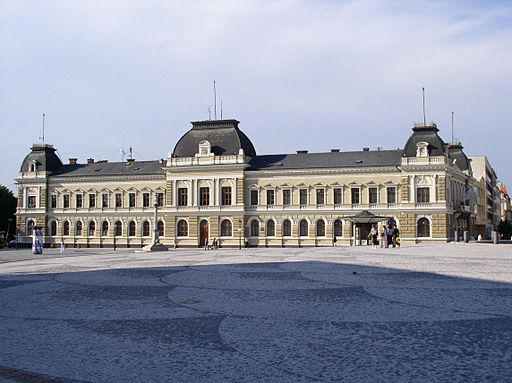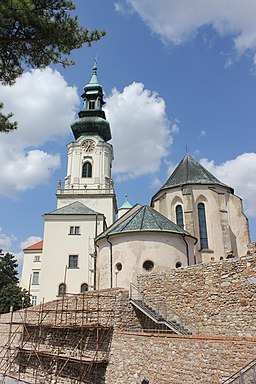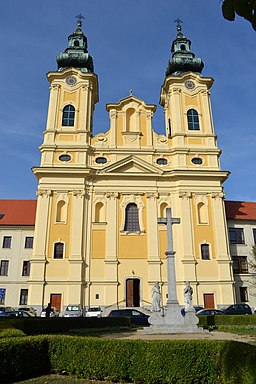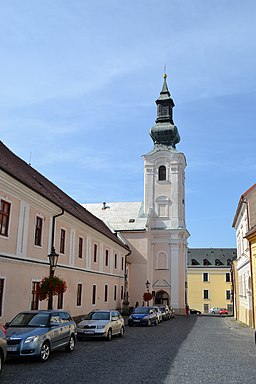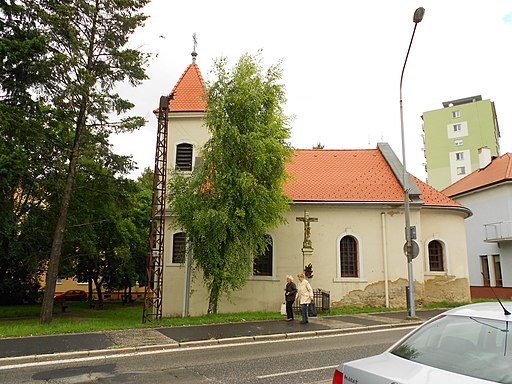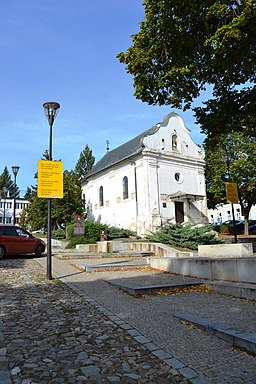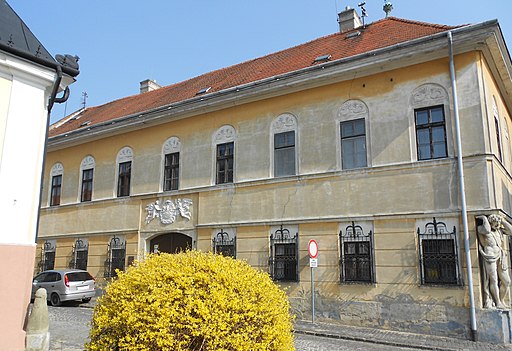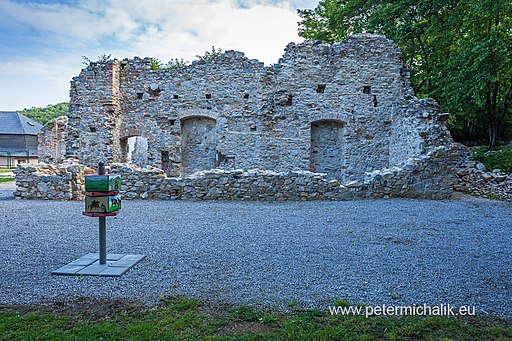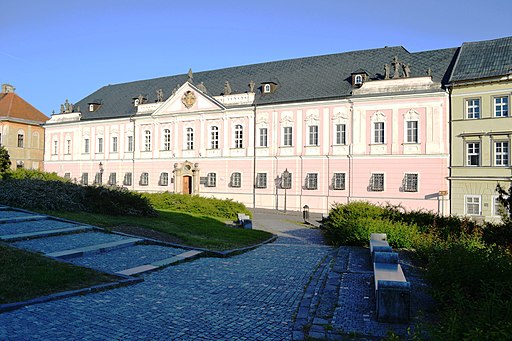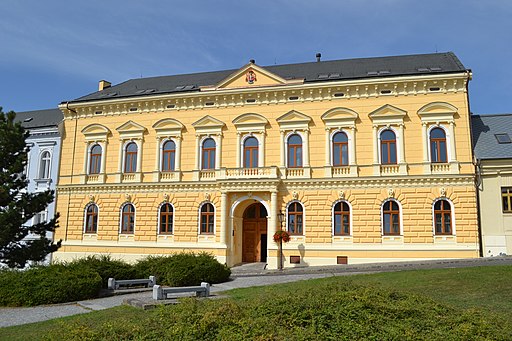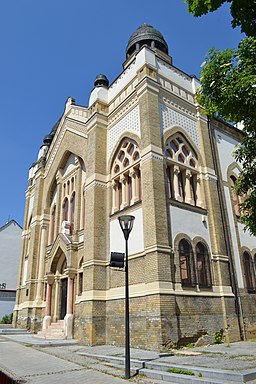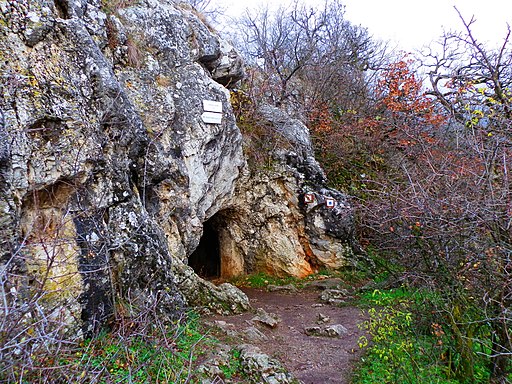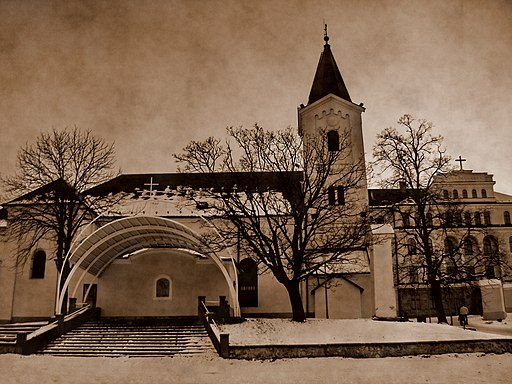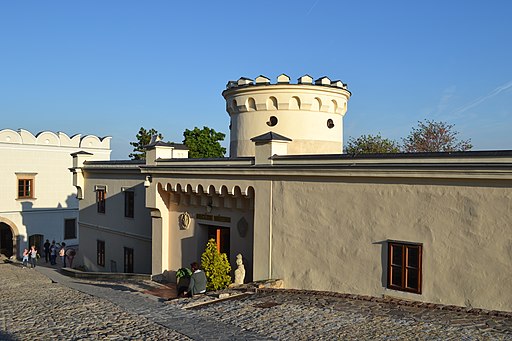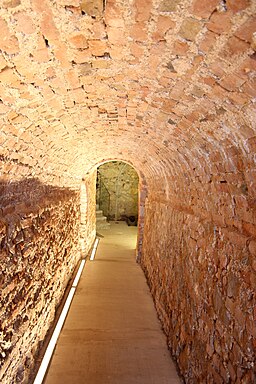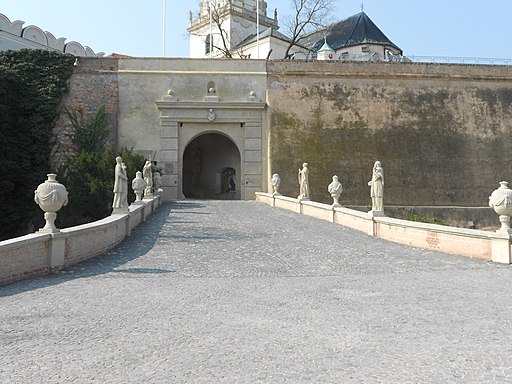Nyitra
Historical Hungarian county:
Nyitra
GPS coordinates:
48.316359, 18.088635
Population
Population in 1910
| Total |
16419 |
| Hungarian |
59.4% |
| German |
9.9% |
| Slovak |
30% |
The town that took its name from the Nyitra River was an important episcopal seat and also the seat of the former Nyitra County and played an important role in the early history of Hungary. The pagan rival of Stephen I, the first Christian king of Hungary, named Vazul was held captive and blinded in its castle. The Bavarian Gisela, the wife of Stephen I, established the predecessor of the present-day cathedral and dedicated it to St. Emmeram, the patron saint of Regensburg. The monastery on Mount Zobor was also founded at that time under the patronage of the Bavarian saint Hippolyte. Nyitra was the seat of the Duchy that was traditionally held by the ruling king's younger brother. Since the dukes often aspired to the throne, this institution was abolished by King Kálmán the Book-Lover, who also established the Bishopric of Nyitra in 1113 and constructed the first stone castle here. The monument erected in 1896 for the Millennium of Hungary was exploded by the Czechoslovak invaders in 1921, but its magnificent pedestal still stands on Mount Zobor next to the radio transmitter. The former Hungarian majority of the town was swept away by the persecutions during the 20th century, but they left behind an indelible mark in the cultural heritage of the town.
Check out other towns in Hungary as well!
825-833
It was the seat of the Principality of Nyitra. Its leader was Priwina of unknown origin.
895
Arrival of the Hungarians
Little more...
895
The alliance of the seven Hungarian tribes took possession of the then largely uninhabited Carpathian Basin. Until then, the sparse Slavic population of the north-western Carpathians had lived under Moravian rule for a few decades after the collapse of the Avar Khaganate in the early 9th century.
1000
Foundation of the Hungarian Kingdom
Little more...
1000
The Kingdom of Hungary was established with the coronation of King Stephen I. He converted the Hungarians to Christianity and created two archdioceses (Esztergom and Kalocsa) and ten dioceses. He divided Hungary into counties led by ispáns, who were appointed by the king.
833
According to a debated theory, Prince Mojmir I of Moravia occupied the Principality of Nyitra.
1000-1038
The reign of King Stephen I of Hungary. A castle was built. The king's cousin, Vazul was imprisoned here. Vazul turned against the king after Stephen I named his son, Imre as his heir. It was against the ancient Hungarian tradition according to which the oldest family member (Vazul) should have inherited the throne. Vazul was blinded and his sons exiled. The king's German wife, Gisela built a chapel dedicated to St. Emmeram, the patron saint of Regensburg. A Benedictine monastery was also built on Mount Zobor. Its patron saint was St. Hyppolit, a Bavarian saint greatly respected by the circle of the queen.
1042
Nyitra was burned by the army of Henry III Holy Roman Emperor, who came in the support of Orseolo Péter, dethroned by the Hungarian aristocracy.
from 1048 to around 1110
It was the seat of the Duchy. The title "duke" belonged to the king's younger brother. From 1048 Béla, from 1064 Géza, from 1074 László, from 1095 Álmos was the duke. The Duchy was abolished by King Kálmán (Coloman) the Book-Lover who had enough of his brother's betrayals.
summer 1074
Henry IV Holy Roman Emperor tried to restore the power of King Salamon, who was driven away by his cousin, Géza. The army of Salamon failed to capture Nyitra, while the army of the Emperor was famished by the tactics of scorched earth and was forced to retreat.
1083
At the initiation of King László I of Hungary the church canonized András and Benedek, two monks of the monastery of Mount Zobor. András died of asceticism, while Benedek died by the hands of robbers.
1108
The Bohemian prince, Svatopluk, broke into Hungary and plundered the area of the Vág and Nyitra rivers. He was called in by Duke Álmos, the king's brother. The defenders of castle Nyitra repelled their attack. King Kálmán of Hungary launched a counter attack. Finally they made peace.
1113
King Kálmán the Book-Lover established the Bishopric of Nyitra. A cathedral was built. The castle was reconstructed to a stone castle.
1241-1242
Mongol Invasion
Little more...
1241-1242
The hordes of the Mongol Empire invaded Hungary and almost completely destroyed it. One third to one half of the population was destroyed. The Mongols also suffered heavy losses in the battle of Muhi and they could not hunt down the king. After their withdrawal, King Béla IV reorganized Hungary. He allowed the feudal lords to build stone castles because they were able to successfully resist the nomadic Mongols. The vast majority of stone castles were built after this. The king called in German, Vlach (Romanian) and Slavic settlers to replace the destroyed population.
1241
King Béla IV of Hungary took a rest in Nyitra during his flight from the Mongol invaders. The pursuing Mongols could not take the castle by siege.
1248
King Béla IV made Nyitra a free royal town, as a recognition of the help provided by its citizens against the Mongols.
April 1271.
Ottokar II of Bohemia occupied and burned the town, along with other towns and castles of northwest Hungary. He wanted to establish his own empire.
July 2, 1271
After the defeat of the army of Ottokar at Mosony, according to the peace treaty the occupied territories were regained by King Stephen V of Hungary.
1288
King László IV of Hungary gave the town to the bishop of Nyitra. The town ceased to be a free royal town.
1301
The extinction of the House of Árpád
Little more...
1301
The House of Árpád, the first Hungarian royal dynasty, died out with the death of King Andrew III. Hungary was ruled by oligarchs, the most powerful of whom was Csák Máté, whose main ally was the Aba family. King Charles I (1308-1342), supported by the Pope, eventually emerged as the most prominent of the contenders for the Hungarian throne. But it took decades to break the power of the oligarchs.
1317
After having enough of Csák Máté's plundering, the bishop of Nyitra excommunicated the oligarch again. At the command of Csák Máté the army of Simon son of Mihály from the Kacsics clan attacked and occupied the town and the castle of Nyitra.
1321
After the death of Csák Máté, King Charles I of Hungary recovered the town and gave it back to the bishop.
1440
After the death of King Albert of the House of Habsburg, the Estates of Hungary elected the Polish Ulászló to the throne. Elisabeth, the widow queen, in order to secure the throne for László, her baby boy, called in the Czech Hussite mercenary leader Jan Jiskra. She gave him the title "Captain of the Mining Towns and Kassa", and gave him the castle of Zólyom.
1440
The bishop of Nyitra, Csetneki László supported queen Elisabeth, which made him the ally of the Hussites.
1440-1441
The Czech Hussites soon occupied much of northern Hungary. They reinforced the castles and turned them into bandit lairs. They were pillaging everywhere and large areas became uninhabited. They wiped out the local German and Hungarian population, who were replaced by Czech and other Slavic settlers. The Czech Hussite devastation largely contributed to the Slavicisation of northern Hungary (now Slovakia).
1462
At the end of the war that King Matthias of Hungary had waged against the Hussites since 1458, Jiskra swore loyalty to the king and handed over the castles he still held. Afterwards Jiskra fought in the service of King Matthias until his death.
October 1471
Vitéz János, the Archbishop of Esztergom forged a conspiracy against King Matthias of Hungary. They invited Prince Casimir Jagiellon, the son of Casimir IV of Poland to the throne, and Vitéz opened the gates of Nyitra before his army. The conspiracy failed shortly after.
December 19, 1471
Archbishop Vitéz János came to an agreement with King Matthias, but the king imprisoned him on the 1st of March, 1472.
spring, 1472
The Poles surrendered Nyitra to King Matthias of Hungary.
1526
Battle of Mohács and the splitting of Hungary into two parts
Little more...
1526
Sultan Suleiman I launched a war against Vienna, instigated by the French. Ferdinand I, Duke of Austria, was the brother-in-law of King Louis II of Hungary. The army of the Ottoman Empire defeated the much smaller Hungarian army at Mohács, and King Louis II died in the battle. A group of the barons elected Ferdinand I of the House of Habsburg to the throne, who promised to defend Hungary from the Turks. He was the younger brother of the most powerful European monarch Emperor Charles V. But the nobility chose the most powerful Hungarian baron, Szapolyai János, who was also crowned as King John I. The country was split in two and a decades-long struggle for power began.
autumn 1526
Podmaniczky István, the Bishop of Nyitra crowned Szapolyai János, because the archbishops of Esztergom and Kalocsa fell in the battle of Mohács.
November 1527
Podmaniczky István, the Bishop of Nyitra crowned also Ferdinand I, the rival of Szapolyai János in Székesfehérvár.
1533
King Ferdinand named Thurzó Ferenc Bishop of Nyitra, who became the owner of the town.
1541
The Turkish occupation of the capital, Buda, and the division of Hungary into three parts
Little more...
1541
The Turks conquered Buda, the capital of Hungary, after the death of King John I. The central part of the country was under Turkish rule for 150 years. The western and northern parts (including present-day Slovakia) formed the Kingdom of Hungary ruled by the Habsburg emperors. The eastern parts (now mainly under Romanian rule) were ruled by the successors of King John I of Hungary, who later established the Principality of Transylvania.
1556
Thurzó Ferenc resigned from his office and got married in order to prevent his family from extinction. He wanted to avoid that the enormous wealth of the family collected from mining and trading be inherited by the king. He obtained the lordships of Árva and Zsolnalitva as a dowry of his wife, Kosztka Borbála. After her death he even converted to Protestantism with his second wife, Zrínyi Katalin.
1570
The establishment of the Principality of Transylvania
Little more...
1570
John II (John Sigismund), the son of King John I of Hungary, renounced the title of King of Hungary in favor of King Maximilian of the House of Habsburg, and henceforth held the title of Prince. This formally created the Principality of Transylvania, which was the eastern half of Hungary not ruled by the Habsburgs and was also a vassal of the Ottoman Empire. John II died in 1571, after which the three nations of Transylvania (the Hungarian nobility, the Székelys and the Saxons) elected the prince.
1582-1588
The bastion fort named "Püspökvár" (Bishop Castle) was constructed.
1604-1606
Uprising of Bocskai István
Little more...
1604-1606
The alliance of the Habsburgs and the Principality of Transylvania was defeated by the Ottoman Empire in the Fifteen Years' War. The war devastated Transylvania, which was occupied by the Habsburg imperial army, and General Basta introduced a reign of terror. The nobility and the burghers were upset about the terror, the plundering mercenaries and the violent Counter-Reformation. Bocskai István decided to lead their uprising after the Habsburg emperor tried to confiscate his estates. Bocskai also rallied the hajdú warriors to his side. He was elected Prince of Transylvania and soon liberated the Kingdom of Hungary from the Habsburgs. In 1605 Bocskai István was crowned King of Hungary with the crown he received from the Turks.
June 11, 1605
Rhédey, the commander of Bocskai István occupied Nyitra by siege.
23 June 1606
Peace of Vienna
Little more...
23 June 1606
Bocski István made peace with Emperor Rudolf. Their agreement secured the constitutional rights of the Estates of Hungary, and the freedom of religion. The counties of Szatmár, Bereg and Ugocsa were annexed to the Principality of Transylvania. Bocskai died of illness in the same year, leaving to his successors the idea of unifying Hungary from Transylvania.
1619
The campaign of Prince Bethlen Gábor of Transylvania in the Thirty Years' War
Little more...
1619
At the beginning of the Thirty Years' War (1618-1648), Prince Bethlen Gábor of Transylvania went to war against the Habsburg emperor as an ally of the rebelling Czech-Moravian-Austrian estates. The whole Kingdom of Hungary joined him, only the Austrian defenders of Pozsony had to be put to the sword. With his allies, he laid siege to Vienna. However, he was forced to abandon the siege because the Habsburg-loyal Hungarian aristocrat Homonnai Drugeth György attacked his heartland with Polish mercenaries. On 25 August 1620, the Diet of Besztercebánya elected Bethlen Gábor King of Hungary as vassal of the Turks. He continued to fight after the defeat of the Czechs at White Mountain on 8 November 1620, but without real chance to achieve decisive victory, he decided to come to an agreement with Emperor Ferdinand II.
September 9, 1620
Prince Bethlen Gábor of Transylvania occupied Nyitra by a one-day siege.
May 1621
Nyitra surrendered to the Imperials.
31 December 1621
Peace of Nikolsburg
Little more...
31 December 1621
Prince Bethlen Gábor of Transylvania made peace with Emperor Ferdinand II. Their agreement secured the constitutional rights of the Estates of Hungary, and later it was supplemented with the freedom of religion. Bethlen renounced the title of King of Hungary in exchange for seven counties of the Upper Tisza region (Szabolcs, Szatmár, Bereg, Ugocsa, Zemplén, Borsod, Abaúj) for the rest of his life, other estates in Hungary as his private property and the imperial title of Duke of Oppeln and Ratibor (Opole and Racibórz), one of the Duchies of Silesia. Prince Bethlen went to war against the Habsburgs in 1623 and 1626, but was unable to negotiate more favourable terms.
1630
Franciscan monks settled down in the town.
1644-1645
The campaign of Prince Rákóczi György I of Transylvania in the Thirty Years' War
Little more...
1644-1645
Prince Rákóczi György I of Transylvania allied with the Swedes and the French in the Thirty Years' War and went to war against the Habsburg Emperor Ferdinand III. On 18 July 1645 his army joined forces with Torstenson's Swedish army under Brno (Moravia). The excellent artillery of Transylvania opened fire on the city walls. However, Rákóczi had to give up the siege, having been informed that the Turks were planning a punitive campaign against Transylvania, because he went to war against the Sultan's prohibition.
June 1645
Prince Rákóczi György I of Transylvania occupied Nyitra, and afterwards he joined the Swedish army in Moravia.
16 December 1645
Peace of Linz
Little more...
16 December 1645
Prince Rákóczi György I of Transylvania made peace with Emperor Ferdinand III. It secured the freedom of religion for the Protestants and extended it also to the serfs. Rákóczi received the same seven Hungarian counties that Prince Bethlen Gábor had also held (Abauj, Zemplén, Borsod, Bereg, Ugocsa, Szabolcs, Szatmár) until his death, and the counties of Szabolcs and Szatmár were also to be inherited by his sons. The Rákóczi family also received several new estates.
1652
At Nagyvezekény, near Nyitra Forgách Ádám, Captain of Érsekújvár defeated a plundering Turkish army of 5 thousand horsemen.
October 12, 1663
After the fall of Érsekújvár the Turks occupied Nyitra because of the betrayal of captain Terjék János.
April 17 - May 3, 1664
The Imperial forces of Koháry István and de Souches took back Nyitra.
1669-1673
Pálffy Miklós, Bishop of Nyitra reinforced the walls.
1686
Recapture of Buda and the liberation of Hungary from the Turks
Little more...
1686
The army of the Holy League recaptured Buda from the Turks by siege. In 1687, the Imperial army invaded the Principality of Transylvania. The liberation was hindered by the French breaking their promise of peace in 1688 and attacking the Habsburg Empire. By 1699, when the Peace of Karlóca was signed, all of Hungary and Croatia had been liberated from the Ottoman Empire with the exception of Temesköz, the area bounded by the Maros, the Tisza and the Danube rivers. It was not until the Peace of Požarevac in 1718 that Temesköz was liberated from the Turks. However, the continuous war against the Turkish invaders and the Habsburg autocracy, which lasted for more than 150 years, wiped out large areas of the Hungarian population, which had previously made up 80% of the country's population, and was replaced by Vlachs (Romanians), Serbs and other Slavic settlers and Germans. The Habsburgs also favoured the settlement of these foreign peoples over the 'rebellious' Hungarians.
1701
Nyitra avoided the decree of Leopold I that ordered the destruction of many Hungarian castles.
1703-1711
Hungarian War of Independence led by Prince Rákóczi Ferenc II
Little more...
1703-1711
After the expulsion of the Turks, the Habsburgs treated Hungary as a newly conquered province and did not respect its constitution. The serfs rose up against the Habsburg ruler because of the sufferings caused by the war and the heavy burdens, and they invited Rákóczi Ferenc II to lead them. Trusting in the help promised by King Louis XIV of France, he accepted. Rákóczi rallied the nobility to his side, and soon most of the country was under his control. The rebels were called the kurucs. In 1704, the French and the Bavarians were defeated at the Battle of Blenheim, depriving the Hungarians of their international allies. The Rusyn, Slovak and Vlach peasants and the Saxons of Szepes supported the fight for freedom, while the Serbs in the south and the Saxons in Transylvania served the Habsburgs. Due to lack of funds Rákóczi could not raise a strong regular army, and in 1710, Hungary was also hit by a severe plague. Rákóczi tried unsuccessfully to forge an alliance with Tsar Peter the Great of Russia. In his absence, without his knowledge, his commander-in-chief, Károlyi Sándor, accepted Emperor Joseph I's peace offer. The Peace of Szatmár formally restored the Hungarian constitution and religious freedom and granted amnesty, but did not ease the burden of serfdom. Rákóczi refused to accept the pardon and went into exile. He died in Rodosto, Turkey.
August 24, 1704
The kuruc commander Bercsényi Miklós occupied Nyitra.
1704-1708
Nyitra was in the hands of Prince Rákóczi Ferenc II.
May 27, 1708
In the kuruc camp at Nyitra a brawl broke out between the regiments of Czelder Orbán and Esze Tamás. Esze Tamás was murdered under unclear circumstances. It was a tragic blow to the kuruc cause.
August 1708
After the lost battle at Trencsén, the kuruc garrison surrendered to the Imperial army of Pálffy János after three days of mortar fire.
18th century
The castle was reconstructed in Baroque style.
1848-1849
Hungarian Revolution and War of Independence
Little more...
1848-1849
Following the news of the Paris Revolution on 22 February 1848, the Hungarian liberal opposition led by Kossuth Lajos demanded the abolition of serfdom, the abolition of the tax exemption of the nobility, a parliament elected by the people, and an independent and accountable national government. The revolution that broke out in Pest on 15 March expressed its demands in 12 points, which, in addition to the above mentioned, included the freedom of the press, equality before the law, the release of the political prisoners and the union with Transylvania. A Hungarian government was formed, Batthyány Lajos became prime minister, and on 11 April Emperor Ferdinand V ratified the reform laws. On August 31 the Emperor demanded the repeal of the laws threatening with military intervention. In September the Emperor unleashed the army of Jelacic, Ban of Croatia, on Hungary, but they were defeated by the Hungarians in the Battle of Pákozd on 29 September. An open war began for the independence of Hungary. The Habsburgs incited the nationalities against the Hungarians. The Rusyns, the Slovenes and most of the Slovaks and Germans supported the cause persistently, but the Vlachs (Romanians) and the Serbians turned against the Hungarians. The glorious Spring Campaign in 1849 led by General Görgei Artúr liberated almost all of Hungary. On 1 May 1849, Emperor Franz Joseph, effectively admitting defeat, asked for the help of Tsar Nicholas I of Russia, who sent an intervention army of 200,000 soldiers against Hungary. The resistance became hopeless against the overwhelming enemy forces and on 13 August Görgei Artúr surrendered to the Russians at Világos. Bloody reprisals followed, and on 6 October 1849, 12 generals and a colonel of the Hungarian Revolution, the martyrs of Arad, were executed in Arad. On the same day, Batthyány Lajos, the first Hungarian Prime Minister, was executed by firing squad in Pest. The Habsburgs introduced total authoritarianism in Hungary, but they also failed to fulfil their promises to the nationalities that had betrayed the Hungarians.
1848
The revolution and war of independence ended the bishop's control over the town.
1867
Austro-Hungarian Compromise
Little more...
1867
The Habsburg Empire was weakened by the defeats it suffered in the implementation of Italian and German unity. The Hungarians wanted to return to the reform laws of 1848, but they did not have the strength to do so. Emperor Franz Joseph and the Hungarian opposition, led by Deák Ferenc, finally agreed to restructure the Empire and abolish absolutism. Hungary was given autonomy in its internal affairs, with its own government and parliament, which was essential for the development of its economy and culture. However, foreign and military affairs remained in the hands of the Habsburgs and served their aspiration for becoming a great power. The majority wanted Hungary's independence, but they were excluded from political power.
1876
The town got railway connection on the Komárom - Érsekújvár - Nyitra - Trencsén line. Afterwards a distillery, an agricultural machine factory, a brewery and a dairy were established.
August 30, 1896
A Millennium Monument was raised on Mount Zobor commemorating the one thousand years anniversary of the Hungarians' migration into the Carpathian basin. It was the artwork of Kallós Ede.
1914-1918
World War I
Little more...
1914-1918
As part of the Austro-Hungarian Monarchy, Hungary took part in the war on the side of the Central Powers.
November 1918 - January 1919
The Czech, Romanian and Serbian occupation of Hungary
Little more...
November 1918 - January 1919
In Hungary, the freemasonic subversion brought the pro-Entente Károlyi Mihály to power. The new government, naively trusting the Entente powers, met all their demands and disbanded the Hungarian military, which rendered the country completely defenseless in the most dire need. Under French and Italian command, Czech, Romanian and Serbian troops invaded large parts of Hungary, where they immediately began the takeover. They fired Hungarian railway workers, officials and teachers, banned the use of the Hungarian language, abolished Hungarian education, and disposed of everything that reminded them of the country's Hungarian past. Hundreds of thousands of Hungarians were forced to leave their homeland, and the forcible assimilation of the remaining Hungarians was begun.
December 9, 1918
The Czechoslovaks invaded Nyitra.
4 June 1920
Trianon Dictate
Little more...
4 June 1920
Hungary was forced to sign the Treaty of Trianon, although the country was not invited to the peace talks. Hungary lost two thirds of its territory that had belonged to it for more than 1000 years. One-third of the Hungarian population came under foreign rule. On the basis of the national principle, countries with a more mixed and less ethnically balanced composition than the former Hungary were created, such as Czechoslovakia and the Kingdom of Serbs, Croats and Slovenes (later Yugoslavia). For example, while 48% of the population of the territory ceded to Czechoslovakia was Slovak and 30% Hungarian, 54% of the population of the former Hungary was Hungarian and 10.6% Slovak. And in the territory that is now part of Serbia, the Hungarians outnumbered the Serbs. The part of the territory allocated to Romania from Hungary was larger than the remaining territory of Hungary, despite the fact that there were 10 million Hungarians and less than 3 million Romanians in the former Hungary. While Hungary used to have the most liberal nationality policy in Europe, the successor states had no respect at all for the national and cultural rights of the indigenous Hungarians and engaged in forced assimilation. The Trianon Dictate destroyed the organic economic unity of the region. Before the First World War, Hungary had a dynamic economy, more advanced than Spain's. After 1920, the successor states formed the so-called "Little Entente", putting Hungary under an economic blockade and sabotaging it on the international stage.
February 9, 1921
Czechoslovak legionaries exploded the Millennium Monument of Mount Zobor.
14 March 1939
First independent Slovakia was established
Little more...
14 March 1939
The first independent Slovakia was established under German patronage. Josef Tiso became president of the country. In 1938, Hungary regained 11,927 km2 of territory from Czechoslovakia under the First Vienna Award. Its population was 869 thousand people, 86.5% of whom were Hungarian. From the remaining territory that Hungary did not get back, Slovakia was formed.
Autumn 1944 - Spring 1945
Soviet occupation
Little more...
Autumn 1944 - Spring 1945
The Soviet Red Army occupied Hungary and Slovakia, which resulted in the recreation of Czechoslovakia.
late March, 1945
The Soviets invaded Nyitra.
5 April 1945
Beneš decrees and the persecution of Hungarians
Little more...
5 April 1945
In Hungarian-majority Kassa, the president of occupying Czechoslovakia, Edvard Beneš, promulgated his government program, the so-called Beneš decrees. As part of this, the Hungarian population was deprived of their rights. Their complete expulsion was planned, with the support of the Soviet Union, and only the veto of the USA prevented it. Under the 'Reslavakization' programme, only those Hungarians who recognised themselves as Slovaks were allowed to regain their rights, thus renouncing all linguistic and cultural rights. In the violent expulsions that followed, nearly 200,000 Hungarians were deprived of their property and expelled from their homeland on the basis of their nationality.
1 January 1993
Dissolution of Czechoslovakia
Little more...
1 January 1993
Czechoslovakia disintegrated due to ethnic differences between Czechs and Slovaks, shortly after the withdrawal of Soviet tanks. Slovakia was formed entirely from territory carved out of historic Hungary, and Slovak national identity is still largely based on falsified history and artificial hatred of Hungarians. Despite deportations, expulsions, forced assimilation and strong economic pressure, there are still nearly half a million Hungarians living in the country.
Castles
Nyitra
Nitriansky hrad
Condition:
Renovated / Good
Show on map
Visit
Sights
All
Churches, religious buildings
Public buildings
Cultural facilities
Town infrastructure
Memorials
Museums and Galleries
Churches, religious buildings
St. Emmeram Cathedral
Bazilika svätého Emeráma
Show on map
Visit
St. Emmeram Cathedral
History
The first church dedicated to St. Emmeram of Regensburg was built at the beginning of the 11th century under the patronage of the Bavarian Gisela, the wife of King Stephen I of Hungary. St. Emmeram was a bishop and martyr, who died in Regensburg, Bavaria.
At the beginning of the 12th century King Kálmán I of Hungary established the diocese of Nyitra. A round church was built in 1158 in Romanesque style. The Upper Church was built between 1333 and 1335 in Gothic style and was modified at the beginning of the 18th century. In addition to this, Bishop Telegdi János of Nyitra built a large Baroque dome between 1621 and 1642, which became the Lower Church. The Chapel of St. Barbara was also added to the Upper Church at that time.
The main altar is adorned by the statues of two saint kings of Hungary, St. Stephen and St. László. On the relief above the chapel of the bishop, St. László can be seen. The statue of St. Emmeram is the oldest statue in present-day Slovakia. The bones of the guardian saints of the cathedral, St. Zoerard-András (Andrew Zorard) and St. Benedict of Szkalka, rest in a coffin made in 1674.
Bishop's Palace
Originally:
Bishop's / Archbishop's Palace
Currently:
Bishop's / Archbishop's Palace
Show on map
Visit
Bishop's Palace
History
The medieval Gothic building was reconstructed in Baroque style by Bishop Erdődy between 1732 and 1739. The statue of Pope John Paul II from 2012 stands before the palace.
Church of the Assumption of the Blessed Virgin Mary into Heaven
Kostol Nanebovzatia Panny Márie
Show on map
Visit
Church of the Assumption of the Blessed Virgin Mary into Heaven
History
The church was standing already in 1446. It was fully reconstructed between 1723 and 1738. The statue of Our Lady of Sorrows on the main altar was made before 1784. It is a place for gaining indulgence.
Church of Virgin Mary of the Sickle
Kostol Navštívenia Panny Márie
Show on map
Visit
Church of Virgin Mary of the Sickle
History
The construction started in 1852 at the initiative of Bishop Palugyay Imre. The church was completed in 1861 in neo-Romanesque style. The main altar depicts Saint Imre, Saint Vincent de Paul, Virgin Mary and Saint Elisabeth.
The feast of Virgin Mary of the Sickle is held in memory of the event when the pregnant Mary visited Elisabeth, who was also pregnant with John the Baptist. The liturgical name of the holiday is "The visitation of the Blessed Virgin Mary". It was traditionally held on July 2 from the 13th century. Later the Second Vatican Council (1962-65) modified the date to May 31. But in Hungary it is still held on July 2, and since this day is also the beginning of the harvest season, the feast bears the name "Virgin Mary of the Sickle" in Hungary.
St. László Piarist Church, Monastery and Grammar School
Piaristický kostol sv. Ladislava
Originally:
church and monastery, school
Show on map
Visit
St. László Piarist Church, Monastery and Grammar School
History
The Piarist Order arrived in Nyitra in 1698 in order to teach poor children. The monastery was built between 1701 and 1702. Between 1702 and 1741 a complex consisting of a church, a grammar school and a college was built from the contributions of Bishop Mattyasovszky László and others. The church that can be seen today was constructed between 1742 and 1789 at the initiative of the rector Nemcsényi Adolf.
The Piarist grammar school of Nyitra operated from 1698 to 1919. In 1919 the Czechoslovak invaders drove away the Piarists and expropriated the buildings. In 1992 the Piarists recovered the buildings and opened a grammar school.
After 1940 the church was marred by ahistorical and inappropriate frescos. These depict the factionary church of Pribina (the prince of Nyitra of unknown origin in the first half of the 9th century), the arrival of Cyril and Methodius in the Great Moravian "Empire", and the inauguration of two Slovak bishops in 1921 after the Czechoslovak invasion of northern Hungary.
St. Peter and Paul Franciscan Church and Monastery
Kostol sv. Petra a Pavla
Originally:
church and monastery
Show on map
Visit
St. Peter and Paul Franciscan Church and Monastery
History
It was built between 1624 and 1634 in Renaissance style by Bishop Telegdi János of Nyitra. It was reconstructed in Baroque style in 1763. The 33 reliefs illustrating the life of St. Francis of Assisi were made around 1760. The reliefs on the facade from 1633 depict St. Peter and St. Paul.
Calvinist Church
Kostol Reformovanej cirkvi na Slovensku
Show on map
Visit
Calvinist Church
History
It was built in 1910 in neo-Renaissance style according to the plans of Gere József.
Greek Catholic Cathedral of Saint Stephen of Hungary
Kostol svätého Štefana
Show on map
Visit
Greek Catholic Cathedral of Saint Stephen of Hungary
History
It is the oldest church of the town. It was built in the 10th century in Romanesque style. A Gothic sacristy was built in the 13th-14th century. At the beginning of the 18th century Bishop Mattyasovszky László reconstructed the church in Baroque style.
St. Michael Chapel
Kostol svätého Michala
Show on map
Visit
St. Michael Chapel
History
The chapel was built by Bezovics Lukács in 1739. Bishop Bende Imre reconstructed it in 1894, and its tower was demolished. The statue of St. Michael the Archangel was made by the sculptor Bártfay Gyula in 1930.
Calvary
Kalvária
Show on map
Visit
Calvary
History
The Calvary was built in the last third of the 19th century with 7 stations. In 1885 another 7 stations were added at the initiative of Bishop Roskoványi Ágoston. The chapel was dedicated to the Holy Sepulcher.
Kluch Palace
Originally:
monastery / nunnery / canon's house / provost residence
Show on map
Visit
Kluch Palace
History
It was built between 1818 and 1821 in Empire style by Bishop Kluch József of Nyitra for the canons. The statue of Atlantis on the corner of the building was carved by Master Lőrinc in 1820. The locals called it Corgony. According to the legend Corgony was a smith, who was so strong, that he alone defended the Upper Town against the Turks. The beer of Nyitra was named after the statue.
Benedictine Abbey on Mount Zobor
Zoborský Kláštor
Originally:
monastery / nunnery / canon's house / provost residence
Show on map
Visit
Benedictine Abbey on Mount Zobor
History
Mount Zobor is 587 meters high and is the southernmost point of the Tribecs Mountain. Only the ruins of the abbey can be seen, and the area is occupied by a sanatorium.
The Benedictine monastery dedicated to St. Hippolit was established during the reign of St. Stephen of Hungary (1000-1038). St. Hippolit was a Bavarian saint venerated in the circles of the Bavarian Queen Gisela, the wife of King Stephen. The most famous hermits of the monastery were Saint Zoerard-András (Andrew Zorard) and his disciple Saint Benedict of Szkalka. Saint Zoerard-András lived in the cave of Mount Szkalka, which rises steeply above the banks of the Vág River. He died of asceticism in 1009. His friend, Benedict moved to the cave after his death. Benedict was attacked by bandits in 1012. As they didn't find anything valuable in his cave, they killed him, dragged his body down to the banks of the Vág River and threw it into the fast-running water. According to the legend an eagle floating steadfastly above the water helped to find his body, which was in perfect condition. He was transported to Nyitra and was buried beside Saint Zoerard-András.
They were ordained saints on July 17, 1083 during the reign of St. László of Hungary together with King Stephen, Prince Imre and Bishop Gellért. Their feast is on July 17. Jakab, the bishop of Nyitra, established a Benedictine Abbey in 1224 at the cave of Szkalka.
The Abbey on Mount Zobor was either taken from the Benedictines by the Archbishop of Esztergom in 1464 or occupied by Archbishop Vitéz János in 1471, after he betrayed King Matthias of Hungary. In 1695 Camaldolese monks from Italy settled down and they built a new church and a monastery that was abandoned in 1782.
Great Seminary, Bishop's Library
Kňazský Seminár sv. Gorazda
Originally:
seminary, library
Show on map
Visit
Great Seminary, Bishop's Library
History
The Great Seminary was built in the second half of the 18th century. The Chapel of St. László can be found upstairs. Its library was founded in 1771, it is the 3rd largest library of present-day Slovakia. It has 66 thousand books mostly in Latin, Hungarian and German language. The northeastern wing of the Great Seminary was turned into a library of the diocese between 1877 and 1878 at the initiative of Bishop Roskoványi Ágoston.
Small Seminary
Note:
Seminary for training priests.
Show on map
Visit
Small Seminary
History
The Small Seminary was built at the beginning of the 18th century on medieval foundations. It was given an eclectic appearance between 1876 and 1884. It is now the home of the Seminary of St. Gozard.
Synagogue
Currently:
dancing / concert hall, exhibition hall
Show on map
Visit
Synagogue
History
The synagogue was built between 1908 and 1911 in Orientalist style according to the plans of Baumhorn Lipót.
Hermit Cave
Svoradova jaskyňa
Show on map
Visit
Public buildings
former County Hall, State Gallery of Nyitra
Nitra Gallery
Show on map
Visit
former County Hall, State Gallery of Nyitra
History
It was built in 1784. It was reconstructed in neo-Baroque style around 1874. There was another reconstruction between 1905 and 1908 in Art-Nouveau style led by the architect Czigler Győző.
former Town Hall, Museum of Nyitra Region
Ponitrianske múzeum
Show on map
Visit
former Town Hall, Museum of Nyitra Region
History
The teachers and students of the Piarist grammar school started to collect the materials for the museum in the middle of the 19th century. The Museum of Nyitra County was established in 1896. The museum was closed in 1951. It was reopened in 1962 in the building of the Great Seminary. Now it is situated in the building of the former town hall.
The construction of the town hall started in 1880 in neo-Renaissance style according to the plans of the architect Lyka János from Nyitra.
Court of Justice, Prison
Okresný súd Nitra
Originally:
court, prison/jail
Show on map
Visit
Court of Justice, Prison
History
It was built between 1901 and 1903 according to the plans of Kiss István.
Cultural facilities
Missionary Museum, Missionary Order of the Verbites on the Calvary
Misijné múzeum
Show on map
Visit
Missionary Museum, Missionary Order of the Verbites on the Calvary
History
Museum of the Diocese
Diecézne múzeum v Nitre
Show on map
Visit
Museum of the Diocese
History
Town infrastructure
Casemates in the Southeastern Bastion of the Castle
Nitriansky hrad
Originally:
castle / fortification
Show on map
Visit
Casemates in the Southeastern Bastion of the Castle
History
The casemates were created in 1664 during the Turkish wars. Bishop Pálffy Tamás built a new wall to the southern side of the bastion. The space between the wall and the bastion was not filled in, but archs were created between the structures and the castle gate was defended from here through loopholes.
Vazul Tower and Castle Well
Originally:
castle / fortification
Show on map
Visit
Vazul Tower and Castle Well
History
Vazul was blinded here in 1037 at the command of King Stephen I of Hungary. Vazul did not accept, that the King named his son Imre as his heir instead of him, because according to the ancient Hungarian tradition the oldest family member was to succeed in power. The tower itself was constructed later. The former castle dungeon is located under the tower. The castle well was 60 meters deep.
Castle Bridge
Show on map
Visit
Castle Bridge
History
The Baroque bridge was built between 1750 and 1780 using bricks. The castle could be accessed through this bridge. At the end of the 19th century the bridge was reinforced with new piers and the arches were walled. During a reconstruction in 2011 the entrepreneur partially demolished the bridge.
Memorials
Millennium Monument on Mount Zobor
Originally:
statue / memorial / relief
Currently:
statue / memorial / relief
Show on map
Visit
Millennium Monument on Mount Zobor
History
The monument stood a few meters to the south of the current TV tower. Its pedestal is still there. The monument was erected in 1896 according to the plans of Berczik Gyula in memory of the 1000th anniversary of Hungary. It was 22 meters high. It consisted of an obelisk and four turul birds, one facing each direction.
According to the Gesta Hungarorum written by Anonymus, the notary of King Béla III of Hungary, the Hungarians under the command of Huba, Szovárd and Kadocsa defeated Zobor, the leader of the Moravians, here and afterwards they hanged him on top of Mount Zobor. But according to the historians the character of Zobor was only invented by Anonymus.
The Czechoslovak invaders of the town exploded the monument in 1921.
Monument of the Heroes Fallen in World War I
Originally:
statue / memorial / relief
Currently:
statue / memorial / relief
Show on map
Visit
Monument of the Heroes Fallen in World War I
History
The monument stands in the park under the castle. It was erected in 1918 in memory of the soldiers of the 14th Hungarian infantry regiment of Nyitra who died a heroic death in World War I. It is the artwork of Finta Sándor. Its original Hungarian inscription was replaced by a Slovak one after the Czechoslovak invasion of the town.
Statue of the Assumption of the Blessed Virgin Mary into Heaven (Plague Column)
Morový Stĺp
Originally:
statue / memorial / relief
Currently:
statue / memorial / relief
Show on map
Visit
Statue of the Assumption of the Blessed Virgin Mary into Heaven (Plague Column)
History
It was erected next to the stairs leading to the castle gate in 1750. The sculptor was Vogerl Márton. The statue was raised by Archbishop Esterházy Imre of Esztergom in memory of the plagues in 1710 and in 1739. On the four corners of its pedestal the statues of Hungarian kings stand: St. Stephen, St. László, St. Imre and Béla IV.
Museums and Galleries
Synagogue
Currently:
dancing / concert hall, exhibition hall
Show on map
Visit
Synagogue
History
The synagogue was built between 1908 and 1911 in Orientalist style according to the plans of Baumhorn Lipót.
former County Hall, State Gallery of Nyitra
Nitra Gallery
Show on map
Visit
former County Hall, State Gallery of Nyitra
History
It was built in 1784. It was reconstructed in neo-Baroque style around 1874. There was another reconstruction between 1905 and 1908 in Art-Nouveau style led by the architect Czigler Győző.
former Town Hall, Museum of Nyitra Region
Ponitrianske múzeum
Show on map
Visit
former Town Hall, Museum of Nyitra Region
History
The teachers and students of the Piarist grammar school started to collect the materials for the museum in the middle of the 19th century. The Museum of Nyitra County was established in 1896. The museum was closed in 1951. It was reopened in 1962 in the building of the Great Seminary. Now it is situated in the building of the former town hall.
The construction of the town hall started in 1880 in neo-Renaissance style according to the plans of the architect Lyka János from Nyitra.
Casemates in the Southeastern Bastion of the Castle
Nitriansky hrad
Originally:
castle / fortification
Show on map
Visit
Casemates in the Southeastern Bastion of the Castle
History
The casemates were created in 1664 during the Turkish wars. Bishop Pálffy Tamás built a new wall to the southern side of the bastion. The space between the wall and the bastion was not filled in, but archs were created between the structures and the castle gate was defended from here through loopholes.
Vazul Tower and Castle Well
Originally:
castle / fortification
Show on map
Visit
Vazul Tower and Castle Well
History
Vazul was blinded here in 1037 at the command of King Stephen I of Hungary. Vazul did not accept, that the King named his son Imre as his heir instead of him, because according to the ancient Hungarian tradition the oldest family member was to succeed in power. The tower itself was constructed later. The former castle dungeon is located under the tower. The castle well was 60 meters deep.
Missionary Museum, Missionary Order of the Verbites on the Calvary
Misijné múzeum
Show on map
Visit
Missionary Museum, Missionary Order of the Verbites on the Calvary
History
Hermit Cave
Svoradova jaskyňa
Show on map
Visit
Museum of the Diocese
Diecézne múzeum v Nitre
Show on map
Visit
Museum of the Diocese
History
{"item":"town","set":{"mapcenter":{"lat":"48.3163590000","long":"18.0886350000"},"townlink":"nyitra-nitra","town":{"townId":27,"active":1,"name_HU":"Nyitra","name_LO":"Nitra\u00a0","name_GE":"Neutra","name_LT":"Nitria","seolink":"nyitra-nitra","listorder":5,"oldcounty":2,"country":2,"division":2,"altitude":"151","gps_lat":"48.3163590000","gps_long":"18.0886350000","population":77,"hungarian_2011":1.83,"population_1910":16419,"hungarian_1910":59.4,"german_1910":9.9,"slovak_1910":30,"romanian_1910":0,"rusin_1910":0,"serbian_1910":0,"croatian_1910":0,"slovenian_1910":0,"coatofarms":"","coatofarms_ref":"","picture":"\u003Ca title=\u0022Xmetov \/ CC BY-SA (https:\/\/creativecommons.org\/licenses\/by-sa\/3.0)\u0022 href=\u0022https:\/\/commons.wikimedia.org\/wiki\/File:Nitriansky_hrad.jpg\u0022\u003E\u003Cimg width=\u0022512\u0022 alt=\u0022Nitriansky hrad\u0022 src=\u0022https:\/\/upload.wikimedia.org\/wikipedia\/commons\/thumb\/4\/47\/Nitriansky_hrad.jpg\/512px-Nitriansky_hrad.jpg\u0022\u003E\u003C\/a\u003E","picture_ref":"\u003Ca href=\u0022https:\/\/commons.wikimedia.org\/wiki\/File:Nitriansky_hrad.jpg\u0022 title=\u0022via Wikimedia Commons\u0022\u003EXmetov\u003C\/a\u003E \/ \u003Ca href=\u0022https:\/\/creativecommons.org\/licenses\/by-sa\/3.0\u0022\u003ECC BY-SA\u003C\/a\u003E","georegion":"Nyitra Region, at the foot of the Tribecs Mountains","river":"Nyitra","description":"The town that took its name from the Nyitra River was an important episcopal seat and also the seat of the former Nyitra County and played an important role in the early history of Hungary. The pagan rival of Stephen I, the first Christian king of Hungary, named Vazul was held captive and blinded in its castle. The Bavarian Gisela, the wife of Stephen I, established the predecessor of the present-day cathedral and dedicated it to St. Emmeram, the patron saint of Regensburg. The monastery on Mount Zobor was also founded at that time under the patronage of the Bavarian saint Hippolyte. Nyitra was the seat of the Duchy that was traditionally held by the ruling king's younger brother. Since the dukes often aspired to the throne, this institution was abolished by King K\u00e1lm\u00e1n the Book-Lover, who also established the Bishopric of Nyitra in 1113 and constructed the first stone castle here. The monument erected in 1896 for the Millennium of Hungary was exploded by the Czechoslovak invaders in 1921, but its magnificent pedestal still stands on Mount Zobor next to the radio transmitter. The former Hungarian majority of the town was swept away by the persecutions during the 20th century, but they left behind an indelible mark in the cultural heritage of the town.","nameorigin":" The name comes from the ancient Germanic river name \u0022Nitrahwa\u0022. \u0022Nid\u0022 means river, \u0022ahwa\u0022 means water.","history":"825-833|It was the seat of the Principality of Nyitra. Its leader was Priwina of unknown origin.@#1|@#3|@833|According to a debated theory, Prince Mojmir I of Moravia occupied the Principality of Nyitra.@1000-1038|The reign of King Stephen I of Hungary. A castle was built. The king's cousin, Vazul was imprisoned here. Vazul turned against the king after Stephen I named his son, Imre as his heir. It was against the ancient Hungarian tradition according to which the oldest family member (Vazul) should have inherited the throne. Vazul was blinded and his sons exiled. The king's German wife, Gisela built a chapel dedicated to St. Emmeram, the patron saint of Regensburg. A Benedictine monastery was also built on Mount Zobor. Its patron saint was St. Hyppolit, a Bavarian saint greatly respected by the circle of the queen.@1042|Nyitra was burned by the army of Henry III Holy Roman Emperor, who came in the support of Orseolo P\u00e9ter, dethroned by the Hungarian aristocracy.@from 1048 to around 1110|It was the seat of the Duchy. The title \u0022duke\u0022 belonged to the king's younger brother. From 1048 B\u00e9la, from 1064 G\u00e9za, from 1074 L\u00e1szl\u00f3, from 1095 \u00c1lmos was the duke. The Duchy was abolished by King K\u00e1lm\u00e1n (Coloman) the Book-Lover who had enough of his brother's betrayals.@summer 1074|Henry IV Holy Roman Emperor tried to restore the power of King Salamon, who was driven away by his cousin, G\u00e9za. The army of Salamon failed to capture Nyitra, while the army of the Emperor was famished by the tactics of scorched earth and was forced to retreat.@1083|At the initiation of King L\u00e1szl\u00f3 I of Hungary the church canonized Andr\u00e1s and Benedek, two monks of the monastery of Mount Zobor. Andr\u00e1s died of asceticism, while Benedek died by the hands of robbers.@1108|The Bohemian prince, Svatopluk, broke into Hungary and plundered the area of the V\u00e1g and Nyitra rivers. He was called in by Duke \u00c1lmos, the king's brother. The defenders of castle Nyitra repelled their attack. King K\u00e1lm\u00e1n of Hungary launched a counter attack. Finally they made peace.@1113|King K\u00e1lm\u00e1n the Book-Lover established the Bishopric of Nyitra. A cathedral was built. The castle was reconstructed to a stone castle.@#5|@1241|King B\u00e9la IV of Hungary took a rest in Nyitra during his flight from the Mongol invaders. The pursuing Mongols could not take the castle by siege.@1248|King B\u00e9la IV made Nyitra a free royal town, as a recognition of the help provided by its citizens against the Mongols.@April 1271.|Ottokar II of Bohemia occupied and burned the town, along with other towns and castles of northwest Hungary. He wanted to establish his own empire.@July 2, 1271|After the defeat of the army of Ottokar at Mosony, according to the peace treaty the occupied territories were regained by King Stephen V of Hungary.@1288|King L\u00e1szl\u00f3 IV of Hungary gave the town to the bishop of Nyitra. The town ceased to be a free royal town.@#6|@1317|After having enough of Cs\u00e1k M\u00e1t\u00e9's plundering, the bishop of Nyitra excommunicated the oligarch again. At the command of Cs\u00e1k M\u00e1t\u00e9 the army of Simon son of Mih\u00e1ly from the Kacsics clan attacked and occupied the town and the castle of Nyitra.@1321|After the death of Cs\u00e1k M\u00e1t\u00e9, King Charles I of Hungary recovered the town and gave it back to the bishop.@1440|After the death of King Albert of the House of Habsburg, the Estates of Hungary elected the Polish Ul\u00e1szl\u00f3 to the throne. Elisabeth, the widow queen, in order to secure the throne for L\u00e1szl\u00f3, her baby boy, called in the Czech Hussite mercenary leader Jan Jiskra. She gave him the title \u0022Captain of the Mining Towns and Kassa\u0022, and gave him the castle of Z\u00f3lyom.@1440|The bishop of Nyitra, Csetneki L\u00e1szl\u00f3 supported queen Elisabeth, which made him the ally of the Hussites.@1440-1441|The Czech Hussites soon occupied much of northern Hungary. They reinforced the castles and turned them into bandit lairs. They were pillaging everywhere and large areas became uninhabited. They wiped out the local German and Hungarian population, who were replaced by Czech and other Slavic settlers. The Czech Hussite devastation largely contributed to the Slavicisation of northern Hungary (now Slovakia).@1462|At the end of the war that King Matthias of Hungary had waged against the Hussites since 1458, Jiskra swore loyalty to the king and handed over the castles he still held. Afterwards Jiskra fought in the service of King Matthias until his death.@October 1471|Vit\u00e9z J\u00e1nos, the Archbishop of Esztergom forged a conspiracy against King Matthias of Hungary. They invited Prince Casimir Jagiellon, the son of Casimir IV of Poland to the throne, and Vit\u00e9z opened the gates of Nyitra before his army. The conspiracy failed shortly after.@December 19, 1471|Archbishop Vit\u00e9z J\u00e1nos came to an agreement with King Matthias, but the king imprisoned him on the 1st of March, 1472.@spring, 1472|The Poles surrendered Nyitra to King Matthias of Hungary.@#8|@autumn 1526|Podmaniczky Istv\u00e1n, the Bishop of Nyitra crowned Szapolyai J\u00e1nos, because the archbishops of Esztergom and Kalocsa fell in the battle of Moh\u00e1cs.@November 1527|Podmaniczky Istv\u00e1n, the Bishop of Nyitra crowned also Ferdinand I, the rival of Szapolyai J\u00e1nos in Sz\u00e9kesfeh\u00e9rv\u00e1r.@1533|King Ferdinand named Thurz\u00f3 Ferenc Bishop of Nyitra, who became the owner of the town.@#9|@1556|Thurz\u00f3 Ferenc resigned from his office and got married in order to prevent his family from extinction. He wanted to avoid that the enormous wealth of the family collected from mining and trading be inherited by the king. He obtained the lordships of \u00c1rva and Zsolnalitva as a dowry of his wife, Kosztka Borb\u00e1la. After her death he even converted to Protestantism with his second wife, Zr\u00ednyi Katalin.@#10|@1582-1588|The bastion fort named \u0022P\u00fcsp\u00f6kv\u00e1r\u0022 (Bishop Castle) was constructed.@#13|@June 11, 1605|Rh\u00e9dey, the commander of Bocskai Istv\u00e1n occupied Nyitra by siege.@#14|@#15|@September 9, 1620|Prince Bethlen G\u00e1bor of Transylvania occupied Nyitra by a one-day siege.@May 1621|Nyitra surrendered to the Imperials.@#16|@1630|Franciscan monks settled down in the town.@#17|@June 1645|Prince R\u00e1k\u00f3czi Gy\u00f6rgy I of Transylvania occupied Nyitra, and afterwards he joined the Swedish army in Moravia.@#18|@1652|At Nagyvezek\u00e9ny, near Nyitra Forg\u00e1ch \u00c1d\u00e1m, Captain of \u00c9rsek\u00fajv\u00e1r defeated a plundering Turkish army of 5 thousand horsemen.@October 12, 1663|After the fall of \u00c9rsek\u00fajv\u00e1r the Turks occupied Nyitra because of the betrayal of captain Terj\u00e9k J\u00e1nos.@April 17 - May 3, 1664|The Imperial forces of Koh\u00e1ry Istv\u00e1n and de Souches took back Nyitra.@1669-1673|P\u00e1lffy Mikl\u00f3s, Bishop of Nyitra reinforced the walls.@#25|@1701|Nyitra avoided the decree of Leopold I that ordered the destruction of many Hungarian castles.@#27|@August 24, 1704|The kuruc commander Bercs\u00e9nyi Mikl\u00f3s occupied Nyitra.@1704-1708|Nyitra was in the hands of Prince R\u00e1k\u00f3czi Ferenc II.@May 27, 1708|In the kuruc camp at Nyitra a brawl broke out between the regiments of Czelder Orb\u00e1n and Esze Tam\u00e1s. Esze Tam\u00e1s was murdered under unclear circumstances. It was a tragic blow to the kuruc cause.@August 1708|After the lost battle at Trencs\u00e9n, the kuruc garrison surrendered to the Imperial army of P\u00e1lffy J\u00e1nos after three days of mortar fire.@18th century|The castle was reconstructed in Baroque style.@#28|@1848|The revolution and war of independence ended the bishop's control over the town.@#30|@1876|The town got railway connection on the Kom\u00e1rom - \u00c9rsek\u00fajv\u00e1r - Nyitra - Trencs\u00e9n line. Afterwards a distillery, an agricultural machine factory, a brewery and a dairy were established.@August 30, 1896|A Millennium Monument was raised on Mount Zobor commemorating the one thousand years anniversary of the Hungarians' migration into the Carpathian basin. It was the artwork of Kall\u00f3s Ede.@#31|@#32|@December 9, 1918|The Czechoslovaks invaded Nyitra.@#36|@February 9, 1921|Czechoslovak legionaries exploded the Millennium Monument of Mount Zobor.@#38|@#41|@late March, 1945|The Soviets invaded Nyitra.@#42|@#44|&varak.hu|https:\/\/varak.hu\/latnivalo\/index\/2481-Nyitra-Var\/"},"castles":[{"castleId":71,"townId":27,"active":1,"name_LO":"Nitriansky hrad","settlement_HU":"Nyitra","settlement_LO":"Nitra","address":"N\u00e1mestie J\u00e1na Pavla II. 1012\/7, 949 01 Nitra","listorder":8,"gps_lat":"48.3185550000","gps_long":"18.0868000000","oldcounty":2,"country":2,"division":2,"cond":1,"entrance":1,"varaklink":"https:\/\/varak.hu\/latnivalo\/index\/2481-Nyitra-Var\/","homepage":"http:\/\/www.nitrianskyhrad.sk\/","openinghours":"http:\/\/www.nitrianskyhrad.sk\/otvaracie-hodiny\/","picture":"\u003Ca title=\u0022Xmetov \/ CC BY-SA (https:\/\/creativecommons.org\/licenses\/by-sa\/3.0)\u0022 href=\u0022https:\/\/commons.wikimedia.org\/wiki\/File:Nitriansky_hrad.jpg\u0022\u003E\u003Cimg width=\u0022512\u0022 alt=\u0022Nitriansky hrad\u0022 src=\u0022https:\/\/upload.wikimedia.org\/wikipedia\/commons\/thumb\/4\/47\/Nitriansky_hrad.jpg\/512px-Nitriansky_hrad.jpg\u0022\u003E\u003C\/a\u003E","picture_ref":"\u003Ca href=\u0022https:\/\/commons.wikimedia.org\/wiki\/File:Nitriansky_hrad.jpg\u0022 title=\u0022via Wikimedia Commons\u0022\u003EXmetov\u003C\/a\u003E \/ \u003Ca href=\u0022https:\/\/creativecommons.org\/licenses\/by-sa\/3.0\u0022\u003ECC BY-SA\u003C\/a\u003E","name":"Nyitra","seolink":"nyitra-castle-nitriansky-hrad","georegion":"Zobor Mountains","description":"","nameorigin":"","history":"#1|@#3|@833|According to a debated theory, Prince Mojmir I of Moravia occupied the Principality of Nyitra.@1000-1038|The reign of King Stephen I of Hungary. A castle was built. The king's cousin, Vazul was imprisoned here. Vazul turned against the king after Stephen I named his son, Imre as his heir. It was against the ancient Hungarian tradition according to which the oldest family member (Vazul) should have inherited the throne. Vazul was blinded and his sons exiled. The king's German wife, Gisela built a chapel dedicated to St. Emmeram, the patron saint of Regensburg.@1042|Nyitra was burned by the army of Henry III Holy Roman Emperor, who came in the support of Orseolo P\u00e9ter, dethroned by the Hungarian aristocracy.@from 1048 to around 1110|It was the seat of the Duchy. The title \u0022duke\u0022 belonged to the king's younger brother. From 1048 B\u00e9la, from 1064 G\u00e9za, from 1074 L\u00e1szl\u00f3, from 1095 \u00c1lmos was the duke. The Duchy was abolished by King K\u00e1lm\u00e1n (Coloman) the Book-Lover who had enough of his brother's betrayals.@summer 1074|Henry IV Holy Roman Emperor tried to restore the power of King Salamon, who was driven away by his cousin, G\u00e9za. The army of Salamon failed to capture Nyitra, while the army of the Emperor was famished by the tactics of scorched earth and was forced to retreat.@1108|The Bohemian prince, Svatopluk, broke into Hungary and plundered the area of the V\u00e1g and Nyitra rivers. He was called in by Duke \u00c1lmos, the king's brother. The defenders of castle Nyitra repelled their attack. King K\u00e1lm\u00e1n of Hungary launched a counter attack. Finally they made peace.@1113|King K\u00e1lm\u00e1n the Book-Lover established the Bishopric of Nyitra. A cathedral was built. The castle was reconstructed to a stone castle.@#5|@1241|King B\u00e9la IV of Hungary took a rest in Nyitra during his flight from the Mongol invaders. The pursuing Mongols could not take the castle by siege.@April 1271.|Ottokar II of Bohemia occupied and burned the town, along with other towns and castles of northwest Hungary. He wanted to establish his own empire.@July 2, 1271|After the defeat of the army of Ottokar at Mosony, according to the peace treaty the occupied territories were regained by King Stephen V of Hungary.@#6|@1317|After having enough of Cs\u00e1k M\u00e1t\u00e9\u2019s plundering, the bishop of Nyitra excommunicated the oligarch again. At the command of Cs\u00e1k M\u00e1t\u00e9 the army of Simon son of Mih\u00e1ly from the Kacsics clan attacked and occupied the town and the castle of Nyitra.@1321|After the death of Cs\u00e1k M\u00e1t\u00e9, King Charles I of Hungary recovered the town and gave it back to the bishop.@1440|After the death of King Albert of the House of Habsburg, the Estates of Hungary elected the Polish Ul\u00e1szl\u00f3 to the throne. Elisabeth, the widow queen, in order to secure the throne for L\u00e1szl\u00f3, her baby boy, called in the Czech Hussite mercenary leader Jan Jiskra. She gave him the title \u0022Captain of the Mining Towns and Kassa\u0022, and gave him the castle of Z\u00f3lyom.@1440|The bishop of Nyitra, Csetneki L\u00e1szl\u00f3 supported Queen Elisabeth, which made him the ally of the Hussites.@1440-1441|The Czech Hussites soon occupied much of northern Hungary. They reinforced the castles and turned them into bandit lairs. They were pillaging everywhere and large areas became uninhabited. They wiped out the local German and Hungarian population, who were replaced by Czech and other Slavic settlers. The Czech Hussite devastation largely contributed to the Slavicisation of northern Hungary (now Slovakia).@1462|At the end of the war that King Matthias of Hungary had waged against the Hussites since 1458, Jiskra swore loyalty to the king and handed over the castles he still held. Afterwards Jiskra fought in the service of King Matthias until his death.@October 1471|Vit\u00e9z J\u00e1nos, the Archbishop of Esztergom forged a conspiracy against King Matthias of Hungary. They invited Prince Casimir Jagiellon, the son of Casimir IV of Poland to the throne, and Vit\u00e9z opened the gates of Nyitra before his army. The conspiracy failed shortly after.@December 19, 1471|Archbishop Vit\u00e9z J\u00e1nos came to an agreement with King Matthias, but the king imprisoned him on the 1st of March, 1472.@spring, 1472|The Poles surrendered Nyitra to King Matthias of Hungary.@#8|@autumn 1526|Podmaniczky Istv\u00e1n, the Bishop of Nyitra crowned Szapolyai J\u00e1nos, because the archbishops of Esztergom and Kalocsa fell in the battle of Moh\u00e1cs.@November 1527|Podmaniczky Istv\u00e1n, the Bishop of Nyitra crowned also Ferdinand I, the rival of Szapolyai J\u00e1nos in Sz\u00e9kesfeh\u00e9rv\u00e1r.@#9|@#10|@1582-1588|The bastion fort named \u0022P\u00fcsp\u00f6kv\u00e1r\u0022 (Bishop castle) was constructed.@#13|@June 11, 1605|Rh\u00e9dey, the commander of Bocskai Istv\u00e1n occupied Nyitra by siege.@#14|@#15|@September 9, 1620|Prince Bethlen G\u00e1bor of Transylvania occupied Nyitra by a one-day siege.@May 1621|Nyitra surrendered to the Imperials.@#16|@#17|@June 1645|Prince R\u00e1k\u00f3czi Gy\u00f6rgy I of Transylvania occupied Nyitra, and afterwards he joined the Swedish army in Moravia.@#18|@October 12, 1663|After the fall of \u00c9rsek\u00fajv\u00e1r the Turks occupied Nyitra because of the betrayal of captain Terj\u00e9k J\u00e1nos.@April 17 - May 3, 1664|The Imperial forces of Koh\u00e1ry Istv\u00e1n and de Souches took back Nyitra.@1669-1673|P\u00e1lffy Mikl\u00f3s, Bishop of Nyitra reinforced the walls.@#25|@1701|Nyitra avoided the decree of Leopold I that ordered the destruction of many Hungarian castles.@#27|@August 24, 1704|The kuruc commander Bercs\u00e9nyi Mikl\u00f3s occupied Nyitra.@1704-1708|Nyitra was in the hands of Prince R\u00e1k\u00f3czi Ferenc II.@August 1708|After the lost battle at Trencs\u00e9n, the kuruc garrison surrendered to the Imperial army of P\u00e1lffy J\u00e1nos after three days of mortar fire.@18th century|The castle was reconstructed in Baroque style.@#28|@#30|@#31|@#32|@#36|&"}],"sights":[{"sightId":496,"townId":27,"active":2,"name_LO":"Bazilika sv\u00e4t\u00e9ho Emer\u00e1ma","address":"Podz\u00e1mska 906\/35, 949 01 Nitra","mapdata":"1|516|185","gps_lat":"48.3184160000","gps_long":"18.0871100000","religion":1,"oldtype":"1","newtype":"1","homepage":"","openinghours":"","muemlekemlink":"https:\/\/www.muemlekem.hu\/hatareset\/Szent-Emmeram-szekesegyhaz-Nyitra-703","csemadoklink":"\n","picture":"\u003Ca title=\u0022Andrzej Otr\u0119bski \/ CC BY-SA (https:\/\/creativecommons.org\/licenses\/by-sa\/4.0)\u0022 href=\u0022https:\/\/commons.wikimedia.org\/wiki\/File:Nitra_katedra_07.jpg\u0022\u003E\u003Cimg width=\u0022256\u0022 alt=\u0022Nitra katedra 07\u0022 src=\u0022https:\/\/upload.wikimedia.org\/wikipedia\/commons\/thumb\/2\/21\/Nitra_katedra_07.jpg\/256px-Nitra_katedra_07.jpg\u0022\u003E\u003C\/a\u003E","picture_ref":"\u003Ca href=\u0022https:\/\/commons.wikimedia.org\/wiki\/File:Nitra_katedra_07.jpg\u0022 title=\u0022via Wikimedia Commons\u0022\u003EAndrzej Otr\u0119bski\u003C\/a\u003E \/ \u003Ca href=\u0022https:\/\/creativecommons.org\/licenses\/by-sa\/4.0\u0022\u003ECC BY-SA\u003C\/a\u003E","name":"St. Emmeram Cathedral ","seolink":"st-emmeram-cathedral","note":"","history":"The first church dedicated to St. Emmeram of Regensburg was built at the beginning of the 11th century under the patronage of the Bavarian Gisela, the wife of King Stephen I of Hungary. St. Emmeram was a bishop and martyr, who died in Regensburg, Bavaria.@At the beginning of the 12th century King K\u00e1lm\u00e1n I of Hungary established the diocese of Nyitra. A round church was built in 1158 in Romanesque style. The Upper Church was built between 1333 and 1335 in Gothic style and was modified at the beginning of the 18th century. In addition to this, Bishop Telegdi J\u00e1nos of Nyitra built a large Baroque dome between 1621 and 1642, which became the Lower Church. The Chapel of St. Barbara was also added to the Upper Church at that time.@The main altar is adorned by the statues of two saint kings of Hungary, St. Stephen and St. L\u00e1szl\u00f3. On the relief above the chapel of the bishop, St. L\u00e1szl\u00f3 can be seen. The statue of St. Emmeram is the oldest statue in present-day Slovakia. The bones of the guardian saints of the cathedral, St. Zoerard-Andr\u00e1s (Andrew Zorard) and St. Benedict of Szkalka, rest in a coffin made in 1674."},{"sightId":497,"townId":27,"active":1,"name_LO":"","address":"","mapdata":"1|545|234","gps_lat":"48.3179010000","gps_long":"18.0875710000","religion":0,"oldtype":"30","newtype":"30","homepage":"","openinghours":"","muemlekemlink":"https:\/\/www.muemlekem.hu\/hatareset\/Nyitrai-var-Nyitra-681","csemadoklink":"\r","picture":"\u003Ca title=\u0022Georgeo88 \/ CC BY-SA (https:\/\/creativecommons.org\/licenses\/by-sa\/4.0)\u0022 href=\u0022https:\/\/commons.wikimedia.org\/wiki\/File:Most_hradn%C3%BD_-_Nitra.JPG\u0022\u003E\u003Cimg width=\u0022512\u0022 alt=\u0022Most hradn\u00fd - Nitra\u0022 src=\u0022https:\/\/upload.wikimedia.org\/wikipedia\/commons\/thumb\/e\/e0\/Most_hradn%C3%BD_-_Nitra.JPG\/512px-Most_hradn%C3%BD_-_Nitra.JPG\u0022\u003E\u003C\/a\u003E","picture_ref":"\u003Ca href=\u0022https:\/\/commons.wikimedia.org\/wiki\/File:Most_hradn%C3%BD_-_Nitra.JPG\u0022 title=\u0022via Wikimedia Commons\u0022\u003EGeorgeo88\u003C\/a\u003E \/ \u003Ca href=\u0022https:\/\/creativecommons.org\/licenses\/by-sa\/4.0\u0022\u003ECC BY-SA\u003C\/a\u003E","name":"Castle Bridge","seolink":"castle-bridge","note":"","history":"The Baroque bridge was built between 1750 and 1780 using bricks. The castle could be accessed through this bridge. At the end of the 19th century the bridge was reinforced with new piers and the arches were walled. During a reconstruction in 2011 the entrepreneur partially demolished the bridge."},{"sightId":498,"townId":27,"active":1,"name_LO":"Morov\u00fd St\u013ap","address":"","mapdata":"1|560|255","gps_lat":"48.3177150000","gps_long":"18.0879360000","religion":1,"oldtype":"38","newtype":"38","homepage":"","openinghours":"","muemlekemlink":"https:\/\/www.muemlekem.hu\/hatareset\/Maria-oszlop-es-szoborcsoport-Nyitra-680","csemadoklink":"http:\/\/emlekhelyek.csemadok.sk\/emlekhelyek\/nagyboldogasszony-szoborcsoport\/\r","picture":"\u003Ca title=\u0022Ingo Mehling \/ CC BY-SA (https:\/\/creativecommons.org\/licenses\/by-sa\/4.0)\u0022 href=\u0022https:\/\/commons.wikimedia.org\/wiki\/File:Nitra_-_Marian_Column.jpg\u0022\u003E\u003Cimg width=\u0022256\u0022 alt=\u0022Nitra - Marian Column\u0022 src=\u0022https:\/\/upload.wikimedia.org\/wikipedia\/commons\/thumb\/3\/3f\/Nitra_-_Marian_Column.jpg\/256px-Nitra_-_Marian_Column.jpg\u0022\u003E\u003C\/a\u003E","picture_ref":"\u003Ca href=\u0022https:\/\/commons.wikimedia.org\/wiki\/File:Nitra_-_Marian_Column.jpg\u0022 title=\u0022via Wikimedia Commons\u0022\u003EIngo Mehling\u003C\/a\u003E \/ \u003Ca href=\u0022https:\/\/creativecommons.org\/licenses\/by-sa\/4.0\u0022\u003ECC BY-SA\u003C\/a\u003E","name":"Statue of the Assumption of the Blessed Virgin Mary into Heaven (Plague Column) ","seolink":"statue-of-the-assumption-of-the-blessed-virgin-mary-into-heaven-plague-column","note":"","history":"It was erected next to the stairs leading to the castle gate in 1750. The sculptor was Vogerl M\u00e1rton. The statue was raised by Archbishop Esterh\u00e1zy Imre of Esztergom in memory of the plagues in 1710 and in 1739. On the four corners of its pedestal the statues of Hungarian kings stand: St. Stephen, St. L\u00e1szl\u00f3, St. Imre and B\u00e9la IV."},{"sightId":499,"townId":27,"active":2,"name_LO":"","address":"Podz\u00e1mska 906\/35, 949 01 Nitra","mapdata":"1|474|191","gps_lat":"48.3183010000","gps_long":"18.0866290000","religion":1,"oldtype":"7","newtype":"7","homepage":"","openinghours":"","muemlekemlink":"","csemadoklink":"\n","picture":"\u003Ca title=\u0022Lestat (Jan Mehlich) \/ CC BY-SA (https:\/\/creativecommons.org\/licenses\/by-sa\/3.0)\u0022 href=\u0022https:\/\/commons.wikimedia.org\/wiki\/File:Nitra_-_Castle_02.jpg\u0022\u003E\u003Cimg width=\u0022512\u0022 alt=\u0022Nitra - Castle 02\u0022 src=\u0022https:\/\/upload.wikimedia.org\/wikipedia\/commons\/thumb\/f\/ff\/Nitra_-_Castle_02.jpg\/512px-Nitra_-_Castle_02.jpg\u0022\u003E\u003C\/a\u003E","picture_ref":"\u003Ca href=\u0022https:\/\/commons.wikimedia.org\/wiki\/File:Nitra_-_Castle_02.jpg\u0022 title=\u0022via Wikimedia Commons\u0022\u003ELestat (Jan Mehlich)\u003C\/a\u003E \/ \u003Ca href=\u0022https:\/\/creativecommons.org\/licenses\/by-sa\/3.0\u0022\u003ECC BY-SA\u003C\/a\u003E","name":"Bishop's Palace ","seolink":"bishops-palace","note":"","history":"The medieval Gothic building was reconstructed in Baroque style by Bishop Erd\u0151dy between 1732 and 1739. The statue of Pope John Paul II from 2012 stands before the palace."},{"sightId":500,"townId":27,"active":1,"name_LO":"Diec\u00e9zne m\u00fazeum v Nitre","address":"N\u00e1mestie J\u00e1na Pavla II. 1012\/7, 949 01 Nitra","mapdata":"1|479|223","gps_lat":"48.3179920000","gps_long":"18.0867980000","religion":1,"oldtype":"120","newtype":"98","homepage":"http:\/\/www.biskupstvo-nitra.sk\/institucie\/diecezne-muzeum\/","openinghours":"http:\/\/www.biskupstvo-nitra.sk\/institucie\/diecezne-muzeum\/","muemlekemlink":"","csemadoklink":"\r","picture":"\u003Ca title=\u0022Ladislav Luppa \/ CC BY-SA (https:\/\/creativecommons.org\/licenses\/by-sa\/4.0)\u0022 href=\u0022https:\/\/commons.wikimedia.org\/wiki\/File:Nitra_-_Diec%C3%A9zne_m%C3%BAzeum.jpg\u0022\u003E\u003Cimg width=\u0022512\u0022 alt=\u0022Nitra - Diec\u00e9zne m\u00fazeum\u0022 src=\u0022https:\/\/upload.wikimedia.org\/wikipedia\/commons\/thumb\/4\/4e\/Nitra_-_Diec%C3%A9zne_m%C3%BAzeum.jpg\/512px-Nitra_-_Diec%C3%A9zne_m%C3%BAzeum.jpg\u0022\u003E\u003C\/a\u003E","picture_ref":"\u003Ca href=\u0022https:\/\/commons.wikimedia.org\/wiki\/File:Nitra_-_Diec%C3%A9zne_m%C3%BAzeum.jpg\u0022 title=\u0022via Wikimedia Commons\u0022\u003ELadislav Luppa\u003C\/a\u003E \/ \u003Ca href=\u0022https:\/\/creativecommons.org\/licenses\/by-sa\/4.0\u0022\u003ECC BY-SA\u003C\/a\u003E","name":"Museum of the Diocese ","seolink":"museum-of-the-diocese","note":"","history":""},{"sightId":501,"townId":27,"active":1,"name_LO":"Kostol Nanebovzatia Panny M\u00e1rie","address":"Kalv\u00e1ria 714, 949 01 Nitra","mapdata":"2|711|489","gps_lat":"48.2986990000","gps_long":"18.0919650000","religion":1,"oldtype":"1","newtype":"1","homepage":"","openinghours":"","muemlekemlink":"","csemadoklink":"\r","picture":"\u003Ca title=\u0022Michal Hru\u0161ka \/ CC BY-SA (https:\/\/creativecommons.org\/licenses\/by-sa\/3.0)\u0022 href=\u0022https:\/\/commons.wikimedia.org\/wiki\/File:Nitrianska_kalv%C3%A1ria,_Kostol_Nanebovzatia_Panny_M%C3%A1rie_03.jpg\u0022\u003E\u003Cimg width=\u0022256\u0022 alt=\u0022Nitrianska kalv\u00e1ria, Kostol Nanebovzatia Panny M\u00e1rie 03\u0022 src=\u0022https:\/\/upload.wikimedia.org\/wikipedia\/commons\/thumb\/2\/2b\/Nitrianska_kalv%C3%A1ria%2C_Kostol_Nanebovzatia_Panny_M%C3%A1rie_03.jpg\/256px-Nitrianska_kalv%C3%A1ria%2C_Kostol_Nanebovzatia_Panny_M%C3%A1rie_03.jpg\u0022\u003E\u003C\/a\u003E","picture_ref":"\u003Ca href=\u0022https:\/\/commons.wikimedia.org\/wiki\/File:Nitrianska_kalv%C3%A1ria,_Kostol_Nanebovzatia_Panny_M%C3%A1rie_03.jpg\u0022 title=\u0022via Wikimedia Commons\u0022\u003EMichal Hru\u0161ka\u003C\/a\u003E \/ \u003Ca href=\u0022https:\/\/creativecommons.org\/licenses\/by-sa\/3.0\u0022\u003ECC BY-SA\u003C\/a\u003E","name":"Church of the Assumption of the Blessed Virgin Mary into Heaven ","seolink":"church-of-the-assumption-of-the-blessed-virgin-mary-into-heaven","note":"","history":"The church was standing already in 1446. It was fully reconstructed between 1723 and 1738. The statue of Our Lady of Sorrows on the main altar was made before 1784. It is a place for gaining indulgence."},{"sightId":502,"townId":27,"active":1,"name_LO":"Nitra Gallery","address":"\u017dupn\u00e9 n\u00e1mestie 962\/3, 949 01 Nitra","mapdata":"1|415|418","gps_lat":"48.3157340000","gps_long":"18.0854420000","religion":0,"oldtype":"11","newtype":"99","homepage":"https:\/\/nitrianskagaleria.sk\/","openinghours":"","muemlekemlink":"","csemadoklink":"http:\/\/emlekhelyek.csemadok.sk\/emlekhelyek\/megyehaza\/\r","picture":"\u003Ca title=\u0022Andrzej Otr\u0119bski \/ CC BY-SA (https:\/\/creativecommons.org\/licenses\/by-sa\/4.0)\u0022 href=\u0022https:\/\/commons.wikimedia.org\/wiki\/File:Nitra_Dom_Zupny_1.jpg\u0022\u003E\u003Cimg width=\u0022512\u0022 alt=\u0022Nitra Dom Zupny 1\u0022 src=\u0022https:\/\/upload.wikimedia.org\/wikipedia\/commons\/thumb\/3\/3b\/Nitra_Dom_Zupny_1.jpg\/512px-Nitra_Dom_Zupny_1.jpg\u0022\u003E\u003C\/a\u003E","picture_ref":"\u003Ca href=\u0022https:\/\/commons.wikimedia.org\/wiki\/File:Nitra_Dom_Zupny_1.jpg\u0022 title=\u0022via Wikimedia Commons\u0022\u003EAndrzej Otr\u0119bski\u003C\/a\u003E \/ \u003Ca href=\u0022https:\/\/creativecommons.org\/licenses\/by-sa\/4.0\u0022\u003ECC BY-SA\u003C\/a\u003E","name":"former County Hall, State Gallery of Nyitra ","seolink":"former-county-hall-state-gallery-of-nyitra","note":"","history":"It was built in 1784. It was reconstructed in neo-Baroque style around 1874. There was another reconstruction between 1905 and 1908 in Art-Nouveau style led by the architect Czigler Gy\u0151z\u0151."},{"sightId":503,"townId":27,"active":1,"name_LO":"Kostol sv. Petra a Pavla","address":"Samova 2, 949 01 Nitra","mapdata":"1|468|408","gps_lat":"48.3159880000","gps_long":"18.0862800000","religion":1,"oldtype":"9","newtype":"1","homepage":"https:\/\/nitra.hm.nrb.sk\/","openinghours":"","muemlekemlink":"","csemadoklink":"\r","picture":"\u003Ca title=\u0022Ladislav Luppa \/ CC BY-SA (https:\/\/creativecommons.org\/licenses\/by-sa\/4.0)\u0022 href=\u0022https:\/\/commons.wikimedia.org\/wiki\/File:Nitra_-_Kostol_sv._Petra_a_Pavla.jpg\u0022\u003E\u003Cimg width=\u0022256\u0022 alt=\u0022Nitra - Kostol sv. Petra a Pavla\u0022 src=\u0022https:\/\/upload.wikimedia.org\/wikipedia\/commons\/thumb\/7\/7f\/Nitra_-_Kostol_sv._Petra_a_Pavla.jpg\/256px-Nitra_-_Kostol_sv._Petra_a_Pavla.jpg\u0022\u003E\u003C\/a\u003E","picture_ref":"\u003Ca href=\u0022https:\/\/commons.wikimedia.org\/wiki\/File:Nitra_-_Kostol_sv._Petra_a_Pavla.jpg\u0022 title=\u0022via Wikimedia Commons\u0022\u003ELadislav Luppa\u003C\/a\u003E \/ \u003Ca href=\u0022https:\/\/creativecommons.org\/licenses\/by-sa\/4.0\u0022\u003ECC BY-SA\u003C\/a\u003E","name":"St. Peter and Paul Franciscan Church and Monastery ","seolink":"st-peter-and-paul-franciscan-church-and-monastery","note":"","history":"It was built between 1624 and 1634 in Renaissance style by Bishop Telegdi J\u00e1nos of Nyitra. It was reconstructed in Baroque style in 1763. The 33 reliefs illustrating the life of St. Francis of Assisi were made around 1760. The reliefs on the facade from 1633 depict St. Peter and St. Paul."},{"sightId":504,"townId":27,"active":1,"name_LO":"K\u0148azsk\u00fd Semin\u00e1r sv. Gorazda","address":"Samova 983\/14","mapdata":"1|592|388","gps_lat":"48.3161700000","gps_long":"18.0884430000","religion":1,"oldtype":"6, 76","newtype":"76","homepage":"http:\/\/www.ksnr.sk\/","openinghours":"","muemlekemlink":"","csemadoklink":"http:\/\/emlekhelyek.csemadok.sk\/emlekhelyek\/nagy-szeminarium\/\n","picture":"\u003Ca title=\u0022Ladislav Luppa \/ CC BY-SA (https:\/\/creativecommons.org\/licenses\/by-sa\/4.0)\u0022 href=\u0022https:\/\/commons.wikimedia.org\/wiki\/File:Nitra_-_Ve%C4%BEk%C3%BD_semin%C3%A1r.jpg\u0022\u003E\u003Cimg width=\u0022512\u0022 alt=\u0022Nitra - Ve\u013ek\u00fd semin\u00e1r\u0022 src=\u0022https:\/\/upload.wikimedia.org\/wikipedia\/commons\/thumb\/2\/21\/Nitra_-_Ve%C4%BEk%C3%BD_semin%C3%A1r.jpg\/512px-Nitra_-_Ve%C4%BEk%C3%BD_semin%C3%A1r.jpg\u0022\u003E\u003C\/a\u003E","picture_ref":"\u003Ca href=\u0022https:\/\/commons.wikimedia.org\/wiki\/File:Nitra_-_Ve%C4%BEk%C3%BD_semin%C3%A1r.jpg\u0022 title=\u0022via Wikimedia Commons\u0022\u003ELadislav Luppa\u003C\/a\u003E \/ \u003Ca href=\u0022https:\/\/creativecommons.org\/licenses\/by-sa\/4.0\u0022\u003ECC BY-SA\u003C\/a\u003E","name":"Great Seminary, Bishop's Library ","seolink":"great-seminary-bishops-library","note":"","history":"The Great Seminary was built in the second half of the 18th century. The Chapel of St. L\u00e1szl\u00f3 can be found upstairs. Its library was founded in 1771, it is the 3rd largest library of present-day Slovakia. It has 66 thousand books mostly in Latin, Hungarian and German language. The northeastern wing of the Great Seminary was turned into a library of the diocese between 1877 and 1878 at the initiative of Bishop Roskov\u00e1nyi \u00c1goston."},{"sightId":505,"townId":27,"active":1,"name_LO":"","address":"Pribinovo n\u00e1mestie 992\/5","mapdata":"1|547|348","gps_lat":"48.3165280000","gps_long":"18.0877300000","religion":1,"oldtype":"6","newtype":"6","homepage":"http:\/\/www.ksnr.sk\/","openinghours":"","muemlekemlink":"","csemadoklink":"http:\/\/emlekhelyek.csemadok.sk\/emlekhelyek\/kis-szeminarium\/\r","picture":"\u003Ca title=\u0022Ladislav Luppa \/ CC BY-SA (https:\/\/creativecommons.org\/licenses\/by-sa\/4.0)\u0022 href=\u0022https:\/\/commons.wikimedia.org\/wiki\/File:Nitra_-_Semin%C3%A1r_sv._Gorazda.jpg\u0022\u003E\u003Cimg width=\u0022512\u0022 alt=\u0022Nitra - Semin\u00e1r sv. Gorazda\u0022 src=\u0022https:\/\/upload.wikimedia.org\/wikipedia\/commons\/thumb\/4\/4d\/Nitra_-_Semin%C3%A1r_sv._Gorazda.jpg\/512px-Nitra_-_Semin%C3%A1r_sv._Gorazda.jpg\u0022\u003E\u003C\/a\u003E","picture_ref":"\u003Ca href=\u0022https:\/\/commons.wikimedia.org\/wiki\/File:Nitra_-_Semin%C3%A1r_sv._Gorazda.jpg\u0022 title=\u0022via Wikimedia Commons\u0022\u003ELadislav Luppa\u003C\/a\u003E \/ \u003Ca href=\u0022https:\/\/creativecommons.org\/licenses\/by-sa\/4.0\u0022\u003ECC BY-SA\u003C\/a\u003E","name":"Small Seminary ","seolink":"small-seminary","note":"Seminary for training priests.","history":"The Small Seminary was built at the beginning of the 18th century on medieval foundations. It was given an eclectic appearance between 1876 and 1884. It is now the home of the Seminary of St. Gozard."},{"sightId":506,"townId":27,"active":1,"name_LO":"Kostol sv\u00e4t\u00e9ho Michala","address":"Na V\u0155\u0161ku 1323, 949 01 Nitra","mapdata":"1|383|646","gps_lat":"48.3131790000","gps_long":"18.0849240000","religion":1,"oldtype":"2","newtype":"2","homepage":"","openinghours":"","muemlekemlink":"","csemadoklink":"\r","picture":"\u003Ca title=\u0022Ladislav Luppa \/ CC BY-SA (https:\/\/creativecommons.org\/licenses\/by-sa\/4.0)\u0022 href=\u0022https:\/\/commons.wikimedia.org\/wiki\/File:Nitra_-_Kaplnka_sv._Michala_Archanjela_(1).jpg\u0022\u003E\u003Cimg width=\u0022256\u0022 alt=\u0022Nitra - Kaplnka sv. Michala Archanjela (1)\u0022 src=\u0022https:\/\/upload.wikimedia.org\/wikipedia\/commons\/thumb\/0\/03\/Nitra_-_Kaplnka_sv._Michala_Archanjela_%281%29.jpg\/256px-Nitra_-_Kaplnka_sv._Michala_Archanjela_%281%29.jpg\u0022\u003E\u003C\/a\u003E","picture_ref":"\u003Ca href=\u0022https:\/\/commons.wikimedia.org\/wiki\/File:Nitra_-_Kaplnka_sv._Michala_Archanjela_(1).jpg\u0022 title=\u0022via Wikimedia Commons\u0022\u003ELadislav Luppa\u003C\/a\u003E \/ \u003Ca href=\u0022https:\/\/creativecommons.org\/licenses\/by-sa\/4.0\u0022\u003ECC BY-SA\u003C\/a\u003E","name":"St. Michael Chapel ","seolink":"st-michael-chapel","note":"","history":"The chapel was built by Bezovics Luk\u00e1cs in 1739. Bishop Bende Imre reconstructed it in 1894, and its tower was demolished. The statue of St. Michael the Archangel was made by the sculptor B\u00e1rtfay Gyula in 1930."},{"sightId":507,"townId":27,"active":1,"name_LO":"Piaristick\u00fd kostol sv. Ladislava","address":"Piaristick\u00e1 10, 949 01 Nitra","mapdata":"1|339|885","gps_lat":"48.3105290000","gps_long":"18.0842000000","religion":1,"oldtype":"9, 74","newtype":"1","homepage":"https:\/\/pssjknr.sk\/gymnazium\/","openinghours":"","muemlekemlink":"https:\/\/www.muemlekem.hu\/hatareset\/Szent-Laszlo-templom-es-piarista-kolostor-Nyitra-1119","csemadoklink":"http:\/\/emlekhelyek.csemadok.sk\/emlekhelyek\/szent-laszlo-piarista-kolostor-templom-es-gimnazium\/\r","picture":"\u003Ca title=\u0022Ladislav Luppa \/ CC BY-SA (https:\/\/creativecommons.org\/licenses\/by-sa\/4.0)\u0022 href=\u0022https:\/\/commons.wikimedia.org\/wiki\/File:Nitra_-_Kostol_sv._Ladislava.jpg\u0022\u003E\u003Cimg width=\u0022256\u0022 alt=\u0022Nitra - Kostol sv. Ladislava\u0022 src=\u0022https:\/\/upload.wikimedia.org\/wikipedia\/commons\/thumb\/a\/a9\/Nitra_-_Kostol_sv._Ladislava.jpg\/256px-Nitra_-_Kostol_sv._Ladislava.jpg\u0022\u003E\u003C\/a\u003E","picture_ref":"\u003Ca href=\u0022https:\/\/commons.wikimedia.org\/wiki\/File:Nitra_-_Kostol_sv._Ladislava.jpg\u0022 title=\u0022via Wikimedia Commons\u0022\u003ELadislav Luppa\u003C\/a\u003E \/ \u003Ca href=\u0022https:\/\/creativecommons.org\/licenses\/by-sa\/4.0\u0022\u003ECC BY-SA\u003C\/a\u003E","name":"St. L\u00e1szl\u00f3 Piarist Church, Monastery and Grammar School ","seolink":"st-laszlo-piarist-church-monastery-and-grammar-school","note":"","history":"The Piarist Order arrived in Nyitra in 1698 in order to teach poor children. The monastery was built between 1701 and 1702. Between 1702 and 1741 a complex consisting of a church, a grammar school and a college was built from the contributions of Bishop Mattyasovszky L\u00e1szl\u00f3 and others. The church that can be seen today was constructed between 1742 and 1789 at the initiative of the rector Nemcs\u00e9nyi Adolf.@The Piarist grammar school of Nyitra operated from 1698 to 1919. In 1919 the Czechoslovak invaders drove away the Piarists and expropriated the buildings. In 1992 the Piarists recovered the buildings and opened a grammar school.@After 1940 the church was marred by ahistorical and inappropriate frescos. These depict the factionary church of Pribina (the prince of Nyitra of unknown origin in the first half of the 9th century), the arrival of Cyril and Methodius in the Great Moravian \u0022Empire\u0022, and the inauguration of two Slovak bishops in 1921 after the Czechoslovak invasion of northern Hungary."},{"sightId":508,"townId":27,"active":1,"name_LO":"Ponitrianske m\u00fazeum","address":"\u0160tef\u00e1nikova trieda 1, 949 01 Nitra","mapdata":"1|576|639","gps_lat":"48.3133760000","gps_long":"18.0881480000","religion":0,"oldtype":"12","newtype":"98","homepage":"http:\/\/www.muzeumnitra.sk\/","openinghours":"http:\/\/www.muzeumnitra.sk\/kontakt.html","muemlekemlink":"","csemadoklink":"\r","picture":"\u003Ca title=\u0022Knieza at en.wikipedia \/ Public domain\u0022 href=\u0022https:\/\/commons.wikimedia.org\/wiki\/File:Svatopluks_Square.JPG\u0022\u003E\u003Cimg width=\u0022512\u0022 alt=\u0022Svatopluks Square\u0022 src=\u0022https:\/\/upload.wikimedia.org\/wikipedia\/commons\/thumb\/c\/c0\/Svatopluks_Square.JPG\/512px-Svatopluks_Square.JPG\u0022\u003E\u003C\/a\u003E","picture_ref":"\u003Ca href=\u0022https:\/\/commons.wikimedia.org\/wiki\/File:Svatopluks_Square.JPG\u0022 title=\u0022via Wikimedia Commons\u0022\u003EKnieza at en.wikipedia\u003C\/a\u003E \/ Public domain","name":"former Town Hall, Museum of Nyitra Region ","seolink":"former-town-hall-museum-of-nyitra-region","note":"","history":"The teachers and students of the Piarist grammar school started to collect the materials for the museum in the middle of the 19th century. The Museum of Nyitra County was established in 1896. The museum was closed in 1951. It was reopened in 1962 in the building of the Great Seminary. Now it is situated in the building of the former town hall.@The construction of the town hall started in 1880 in neo-Renaissance style according to the plans of the architect Lyka J\u00e1nos from Nyitra."},{"sightId":509,"townId":27,"active":1,"name_LO":"","address":"Pri synag\u00f3ge 1387\/3, 949 01 Nitra","mapdata":"1|467|785","gps_lat":"48.3115870000","gps_long":"18.0863290000","religion":6,"oldtype":"8","newtype":"92, 105","homepage":"https:\/\/www.nitra.sk\/zobraz\/sekciu\/synagoga","openinghours":"","muemlekemlink":"https:\/\/www.muemlekem.hu\/hatareset\/Zsinagoga-Nyitra-995","csemadoklink":"http:\/\/emlekhelyek.csemadok.sk\/emlekhelyek\/zsinagoga\/\r","picture":"\u003Ca title=\u0022Ladislav Luppa \/ CC BY-SA (https:\/\/creativecommons.org\/licenses\/by-sa\/4.0)\u0022 href=\u0022https:\/\/commons.wikimedia.org\/wiki\/File:Nitra_-_Synag%C3%B3ga.jpg\u0022\u003E\u003Cimg width=\u0022256\u0022 alt=\u0022Nitra - Synag\u00f3ga\u0022 src=\u0022https:\/\/upload.wikimedia.org\/wikipedia\/commons\/thumb\/f\/f4\/Nitra_-_Synag%C3%B3ga.jpg\/256px-Nitra_-_Synag%C3%B3ga.jpg\u0022\u003E\u003C\/a\u003E","picture_ref":"\u003Ca href=\u0022https:\/\/commons.wikimedia.org\/wiki\/File:Nitra_-_Synag%C3%B3ga.jpg\u0022 title=\u0022via Wikimedia Commons\u0022\u003ELadislav Luppa\u003C\/a\u003E \/ \u003Ca href=\u0022https:\/\/creativecommons.org\/licenses\/by-sa\/4.0\u0022\u003ECC BY-SA\u003C\/a\u003E","name":"Synagogue","seolink":"synagogue","note":"","history":"The synagogue was built between 1908 and 1911 in Orientalist style according to the plans of Baumhorn Lip\u00f3t."},{"sightId":510,"townId":27,"active":1,"name_LO":"Misijn\u00e9 m\u00fazeum","address":"Kalv\u00e1ria 715\/3, 949 01 Nitra","mapdata":"2|691|506","gps_lat":"48.2983980000","gps_long":"18.0914620000","religion":1,"oldtype":"98","newtype":"98","homepage":"https:\/\/www.verbisti.sk\/","openinghours":"","muemlekemlink":"","csemadoklink":"\r","picture":"\u003Ca title=\u0022Michal Hru\u0161ka \/ CC BY-SA (https:\/\/creativecommons.org\/licenses\/by-sa\/3.0)\u0022 href=\u0022https:\/\/commons.wikimedia.org\/wiki\/File:Nitrianska_kalv%C3%A1ria,_Kostol_Nanebovzatia_Panny_M%C3%A1rie_01.jpg\u0022\u003E\u003Cimg width=\u0022512\u0022 alt=\u0022Nitrianska kalv\u00e1ria, Kostol Nanebovzatia Panny M\u00e1rie 01\u0022 src=\u0022https:\/\/upload.wikimedia.org\/wikipedia\/commons\/thumb\/4\/44\/Nitrianska_kalv%C3%A1ria%2C_Kostol_Nanebovzatia_Panny_M%C3%A1rie_01.jpg\/512px-Nitrianska_kalv%C3%A1ria%2C_Kostol_Nanebovzatia_Panny_M%C3%A1rie_01.jpg\u0022\u003E\u003C\/a\u003E","picture_ref":"\u003Ca href=\u0022https:\/\/commons.wikimedia.org\/wiki\/File:Nitrianska_kalv%C3%A1ria,_Kostol_Nanebovzatia_Panny_M%C3%A1rie_01.jpg\u0022 title=\u0022via Wikimedia Commons\u0022\u003EMichal Hru\u0161ka\u003C\/a\u003E \/ \u003Ca href=\u0022https:\/\/creativecommons.org\/licenses\/by-sa\/3.0\u0022\u003ECC BY-SA\u003C\/a\u003E","name":"Missionary Museum, Missionary Order of the Verbites on the Calvary ","seolink":"missionary-museum-missionary-order-of-the-verbites-on-the-calvary","note":"","history":""},{"sightId":511,"townId":27,"active":1,"name_LO":"Zoborsk\u00fd Kl\u00e1\u0161tor","address":"Kl\u00e1\u0161torsk\u00e1 1878\/148, 949 01 Nitra-Lie\u010debn\u00fd \u00fastav","mapdata":"3|441|310","gps_lat":"48.3450780000","gps_long":"18.0916380000","religion":1,"oldtype":"5","newtype":"122","homepage":"","openinghours":"","muemlekemlink":"","csemadoklink":"\r","picture":"\u003Ca title=\u0022Photograph: PeterMichalik \/ CC BY-SA (https:\/\/creativecommons.org\/licenses\/by-sa\/4.0)\u0022 href=\u0022https:\/\/commons.wikimedia.org\/wiki\/File:Zoborsky_klastor.jpg\u0022\u003E\u003Cimg width=\u0022512\u0022 alt=\u0022Zoborsky klastor\u0022 src=\u0022https:\/\/upload.wikimedia.org\/wikipedia\/commons\/thumb\/c\/c4\/Zoborsky_klastor.jpg\/512px-Zoborsky_klastor.jpg\u0022\u003E\u003C\/a\u003E","picture_ref":"\u003Ca href=\u0022https:\/\/commons.wikimedia.org\/wiki\/File:Zoborsky_klastor.jpg\u0022 title=\u0022via Wikimedia Commons\u0022\u003EPhotograph: PeterMichalik\u003C\/a\u003E \/ \u003Ca href=\u0022https:\/\/creativecommons.org\/licenses\/by-sa\/4.0\u0022\u003ECC BY-SA\u003C\/a\u003E","name":"Benedictine Abbey on Mount Zobor ","seolink":"benedictine-abbey-on-mount-zobor","note":"","history":"Mount Zobor is 587 meters high and is the southernmost point of the Tribecs Mountain. Only the ruins of the abbey can be seen, and the area is occupied by a sanatorium.@The Benedictine monastery dedicated to St. Hippolit was established during the reign of St. Stephen of Hungary (1000-1038). St. Hippolit was a Bavarian saint venerated in the circles of the Bavarian Queen Gisela, the wife of King Stephen. The most famous hermits of the monastery were Saint Zoerard-Andr\u00e1s (Andrew Zorard) and his disciple Saint Benedict of Szkalka. Saint Zoerard-Andr\u00e1s lived in the cave of Mount Szkalka, which rises steeply above the banks of the V\u00e1g River. He died of asceticism in 1009. His friend, Benedict moved to the cave after his death. Benedict was attacked by bandits in 1012. As they didn't find anything valuable in his cave, they killed him, dragged his body down to the banks of the V\u00e1g River and threw it into the fast-running water. According to the legend an eagle floating steadfastly above the water helped to find his body, which was in perfect condition. He was transported to Nyitra and was buried beside Saint Zoerard-Andr\u00e1s.@They were ordained saints on July 17, 1083 during the reign of St. L\u00e1szl\u00f3 of Hungary together with King Stephen, Prince Imre and Bishop Gell\u00e9rt. Their feast is on July 17. Jakab, the bishop of Nyitra, established a Benedictine Abbey in 1224 at the cave of Szkalka.@The Abbey on Mount Zobor was either taken from the Benedictines by the Archbishop of Esztergom in 1464 or occupied by Archbishop Vit\u00e9z J\u00e1nos in 1471, after he betrayed King Matthias of Hungary. In 1695 Camaldolese monks from Italy settled down and they built a new church and a monastery that was abandoned in 1782."},{"sightId":512,"townId":27,"active":1,"name_LO":"Svoradova jasky\u0148a","address":"","mapdata":"3|500|233","gps_lat":"48.3469190000","gps_long":"18.0929810000","religion":1,"oldtype":"104","newtype":"104","homepage":"","openinghours":"","muemlekemlink":"","csemadoklink":"\r","picture":"\u003Ca title=\u0022Michal Jakubsk\u00fd \/ CC BY (https:\/\/creativecommons.org\/licenses\/by\/3.0)\u0022 href=\u0022https:\/\/commons.wikimedia.org\/wiki\/File:Svoradova_jasky%C5%88a_-_panoramio.jpg\u0022\u003E\u003Cimg width=\u0022512\u0022 alt=\u0022Svoradova jasky\u0148a - panoramio\u0022 src=\u0022https:\/\/upload.wikimedia.org\/wikipedia\/commons\/thumb\/7\/71\/Svoradova_jasky%C5%88a_-_panoramio.jpg\/512px-Svoradova_jasky%C5%88a_-_panoramio.jpg\u0022\u003E\u003C\/a\u003E","picture_ref":"\u003Ca href=\u0022https:\/\/commons.wikimedia.org\/wiki\/File:Svoradova_jasky%C5%88a_-_panoramio.jpg\u0022 title=\u0022via Wikimedia Commons\u0022\u003EMichal Jakubsk\u00fd\u003C\/a\u003E \/ \u003Ca href=\u0022https:\/\/creativecommons.org\/licenses\/by\/3.0\u0022\u003ECC BY\u003C\/a\u003E","name":"Hermit Cave ","seolink":"hermit-cave","note":"","history":""},{"sightId":513,"townId":27,"active":1,"name_LO":"","address":"Samova 16, 949 01 Nitra","mapdata":"1|616|366","gps_lat":"48.3163410000","gps_long":"18.0888000000","religion":0,"oldtype":"5","newtype":"120","homepage":"","openinghours":"","muemlekemlink":"","csemadoklink":"http:\/\/emlekhelyek.csemadok.sk\/emlekhelyek\/kluch-palota\/\r","picture":"\u003Ca title=\u0022Georgeo88 \/ CC BY-SA (https:\/\/creativecommons.org\/licenses\/by-sa\/4.0)\u0022 href=\u0022https:\/\/commons.wikimedia.org\/wiki\/File:Samova_ul._16,_Nitra.JPG\u0022\u003E\u003Cimg width=\u0022512\u0022 alt=\u0022Samova ul. 16, Nitra\u0022 src=\u0022https:\/\/upload.wikimedia.org\/wikipedia\/commons\/thumb\/a\/ae\/Samova_ul._16%2C_Nitra.JPG\/512px-Samova_ul._16%2C_Nitra.JPG\u0022\u003E\u003C\/a\u003E","picture_ref":"\u003Ca href=\u0022https:\/\/commons.wikimedia.org\/wiki\/File:Samova_ul._16,_Nitra.JPG\u0022 title=\u0022via Wikimedia Commons\u0022\u003EGeorgeo88\u003C\/a\u003E \/ \u003Ca href=\u0022https:\/\/creativecommons.org\/licenses\/by-sa\/4.0\u0022\u003ECC BY-SA\u003C\/a\u003E","name":"Kluch Palace","seolink":"kluch-palace","note":"","history":"It was built between 1818 and 1821 in Empire style by Bishop Kluch J\u00f3zsef of Nyitra for the canons. The statue of Atlantis on the corner of the building was carved by Master L\u0151rinc in 1820. The locals called it Corgony. According to the legend Corgony was a smith, who was so strong, that he alone defended the Upper Town against the Turks. The beer of Nyitra was named after the statue."},{"sightId":514,"townId":27,"active":1,"name_LO":"Kalv\u00e1ria","address":"","mapdata":"2|630|593","gps_lat":"48.2964630000","gps_long":"18.0894630000","religion":1,"oldtype":"3","newtype":"3","homepage":"","openinghours":"","muemlekemlink":"","csemadoklink":"\r","picture":"\u003Ca title=\u0022Bojars \/ CC BY-SA (https:\/\/creativecommons.org\/licenses\/by-sa\/4.0)\u0022 href=\u0022https:\/\/commons.wikimedia.org\/wiki\/File:Kalvaria-nitra-12.jpg\u0022\u003E\u003Cimg width=\u0022512\u0022 alt=\u0022Kalvaria-nitra-12\u0022 src=\u0022https:\/\/upload.wikimedia.org\/wikipedia\/commons\/thumb\/c\/ce\/Kalvaria-nitra-12.jpg\/512px-Kalvaria-nitra-12.jpg\u0022\u003E\u003C\/a\u003E","picture_ref":"\u003Ca href=\u0022https:\/\/commons.wikimedia.org\/wiki\/File:Kalvaria-nitra-12.jpg\u0022 title=\u0022via Wikimedia Commons\u0022\u003EBojars\u003C\/a\u003E \/ \u003Ca href=\u0022https:\/\/creativecommons.org\/licenses\/by-sa\/4.0\u0022\u003ECC BY-SA\u003C\/a\u003E","name":"Calvary","seolink":"calvary","note":"","history":"The Calvary was built in the last third of the 19th century with 7 stations. In 1885 another 7 stations were added at the initiative of Bishop Roskov\u00e1nyi \u00c1goston. The chapel was dedicated to the Holy Sepulcher."},{"sightId":515,"townId":27,"active":1,"name_LO":"Nitriansky hrad","address":"","mapdata":"1|555|195","gps_lat":"48.3183850000","gps_long":"18.0877890000","religion":0,"oldtype":"22","newtype":"98","homepage":"","openinghours":"","muemlekemlink":"","csemadoklink":"\r","picture":"\u003Ca title=\u0022Andrzej Otr\u0119bski \/ CC BY-SA (https:\/\/creativecommons.org\/licenses\/by-sa\/4.0)\u0022 href=\u0022https:\/\/commons.wikimedia.org\/wiki\/File:Nitra_zamek_05.jpg\u0022\u003E\u003Cimg width=\u0022256\u0022 alt=\u0022Nitra zamek 05\u0022 src=\u0022https:\/\/upload.wikimedia.org\/wikipedia\/commons\/thumb\/8\/88\/Nitra_zamek_05.jpg\/256px-Nitra_zamek_05.jpg\u0022\u003E\u003C\/a\u003E","picture_ref":"\u003Ca href=\u0022https:\/\/commons.wikimedia.org\/wiki\/File:Nitra_zamek_05.jpg\u0022 title=\u0022via Wikimedia Commons\u0022\u003EAndrzej Otr\u0119bski\u003C\/a\u003E \/ \u003Ca href=\u0022https:\/\/creativecommons.org\/licenses\/by-sa\/4.0\u0022\u003ECC BY-SA\u003C\/a\u003E","name":"Casemates in the Southeastern Bastion of the Castle","seolink":"casemates-in-the-southeastern-bastion-of-the-castle","note":"","history":"The casemates were created in 1664 during the Turkish wars. Bishop P\u00e1lffy Tam\u00e1s built a new wall to the southern side of the bastion. The space between the wall and the bastion was not filled in, but archs were created between the structures and the castle gate was defended from here through loopholes."},{"sightId":516,"townId":27,"active":1,"name_LO":"Kostol Nav\u0161t\u00edvenia Panny M\u00e1rie","address":"Farsk\u00e1, 949 01 Nitra","mapdata":"1|435|717","gps_lat":"48.3124010000","gps_long":"18.0855790000","religion":1,"oldtype":"1","newtype":"1","homepage":"https:\/\/dolnemesto.fara.sk\/","openinghours":"","muemlekemlink":"","csemadoklink":"http:\/\/emlekhelyek.csemadok.sk\/emlekhelyek\/sarlos-nagyboldogasszony-templom\/\r","picture":"\u003Ca title=\u0022Ladislav Luppa \/ CC BY-SA (https:\/\/creativecommons.org\/licenses\/by-sa\/4.0)\u0022 href=\u0022https:\/\/commons.wikimedia.org\/wiki\/File:Nitra_-_Domov_ml%C3%A1de%C5%BEe_pri_SK%C5%A0,_Farsk%C3%A1_21.jpg\u0022\u003E\u003Cimg width=\u0022256\u0022 alt=\u0022Nitra - Domov ml\u00e1de\u017ee pri SK\u0160, Farsk\u00e1 21\u0022 src=\u0022https:\/\/upload.wikimedia.org\/wikipedia\/commons\/thumb\/9\/95\/Nitra_-_Domov_ml%C3%A1de%C5%BEe_pri_SK%C5%A0%2C_Farsk%C3%A1_21.jpg\/256px-Nitra_-_Domov_ml%C3%A1de%C5%BEe_pri_SK%C5%A0%2C_Farsk%C3%A1_21.jpg\u0022\u003E\u003C\/a\u003E","picture_ref":"\u003Ca href=\u0022https:\/\/commons.wikimedia.org\/wiki\/File:Nitra_-_Domov_ml%C3%A1de%C5%BEe_pri_SK%C5%A0,_Farsk%C3%A1_21.jpg\u0022 title=\u0022via Wikimedia Commons\u0022\u003ELadislav Luppa\u003C\/a\u003E \/ \u003Ca href=\u0022https:\/\/creativecommons.org\/licenses\/by-sa\/4.0\u0022\u003ECC BY-SA\u003C\/a\u003E","name":"Church of Virgin Mary of the Sickle ","seolink":"church-of-virgin-mary-of-the-sickle","note":"","history":"The construction started in 1852 at the initiative of Bishop Palugyay Imre. The church was completed in 1861 in neo-Romanesque style. The main altar depicts Saint Imre, Saint Vincent de Paul, Virgin Mary and Saint Elisabeth.@The feast of Virgin Mary of the Sickle is held in memory of the event when the pregnant Mary visited Elisabeth, who was also pregnant with John the Baptist. The liturgical name of the holiday is \u0022The visitation of the Blessed Virgin Mary\u0022. It was traditionally held on July 2 from the 13th century. Later the Second Vatican Council (1962-65) modified the date to May 31. But in Hungary it is still held on July 2, and since this day is also the beginning of the harvest season, the feast bears the name \u0022Virgin Mary of the Sickle\u0022 in Hungary."},{"sightId":517,"townId":27,"active":1,"name_LO":"Kostol sv\u00e4t\u00e9ho \u0160tefana","address":"P\u00e1rovsk\u00e1 1186\/2, 949 01 Nitra","mapdata":"1|212|746","gps_lat":"48.3120550000","gps_long":"18.0819620000","religion":4,"oldtype":"1","newtype":"1","homepage":"https:\/\/grkatnr.sk\/","openinghours":"","muemlekemlink":"","csemadoklink":"http:\/\/emlekhelyek.csemadok.sk\/emlekhelyek\/szent-istvan-kiraly-templom\/\r","picture":"\u003Ca title=\u0022Georgeo88 \/ CC BY-SA (https:\/\/creativecommons.org\/licenses\/by-sa\/3.0)\u0022 href=\u0022https:\/\/commons.wikimedia.org\/wiki\/File:Kostol_sv._%C5%A0tefana_2,_Nitra.JPG\u0022\u003E\u003Cimg width=\u0022512\u0022 alt=\u0022Kostol sv. \u0160tefana 2, Nitra\u0022 src=\u0022https:\/\/upload.wikimedia.org\/wikipedia\/commons\/thumb\/b\/ba\/Kostol_sv._%C5%A0tefana_2%2C_Nitra.JPG\/512px-Kostol_sv._%C5%A0tefana_2%2C_Nitra.JPG\u0022\u003E\u003C\/a\u003E","picture_ref":"\u003Ca href=\u0022https:\/\/commons.wikimedia.org\/wiki\/File:Kostol_sv._%C5%A0tefana_2,_Nitra.JPG\u0022 title=\u0022via Wikimedia Commons\u0022\u003EGeorgeo88\u003C\/a\u003E \/ \u003Ca href=\u0022https:\/\/creativecommons.org\/licenses\/by-sa\/3.0\u0022\u003ECC BY-SA\u003C\/a\u003E","name":"Greek Catholic Cathedral of Saint Stephen of Hungary ","seolink":"greek-catholic-cathedral-of-saint-stephen-of-hungary","note":"","history":"It is the oldest church of the town. It was built in the 10th century in Romanesque style. A Gothic sacristy was built in the 13th-14th century. At the beginning of the 18th century Bishop Mattyasovszky L\u00e1szl\u00f3 reconstructed the church in Baroque style."},{"sightId":518,"townId":27,"active":1,"name_LO":"","address":"","mapdata":"1|541|183","gps_lat":"48.3184010000","gps_long":"18.0876630000","religion":0,"oldtype":"22","newtype":"98","homepage":"","openinghours":"","muemlekemlink":"","csemadoklink":"http:\/\/emlekhelyek.csemadok.sk\/emlekhelyek\/vazul-torony\/\r","picture":"\u003Ca title=\u0022Ladislav Luppa \/ CC BY-SA (https:\/\/creativecommons.org\/licenses\/by-sa\/4.0)\u0022 href=\u0022https:\/\/commons.wikimedia.org\/wiki\/File:Nitra_-_Nitriansky_hrad_-_N%C3%A1ro%C5%BEn%C3%A1_ve%C5%BEa.jpg\u0022\u003E\u003Cimg width=\u0022256\u0022 alt=\u0022Nitra - Nitriansky hrad - N\u00e1ro\u017en\u00e1 ve\u017ea\u0022 src=\u0022https:\/\/upload.wikimedia.org\/wikipedia\/commons\/thumb\/a\/a8\/Nitra_-_Nitriansky_hrad_-_N%C3%A1ro%C5%BEn%C3%A1_ve%C5%BEa.jpg\/256px-Nitra_-_Nitriansky_hrad_-_N%C3%A1ro%C5%BEn%C3%A1_ve%C5%BEa.jpg\u0022\u003E\u003C\/a\u003E","picture_ref":"\u003Ca href=\u0022https:\/\/commons.wikimedia.org\/wiki\/File:Nitra_-_Nitriansky_hrad_-_N%C3%A1ro%C5%BEn%C3%A1_ve%C5%BEa.jpg\u0022 title=\u0022via Wikimedia Commons\u0022\u003ELadislav Luppa\u003C\/a\u003E \/ \u003Ca href=\u0022https:\/\/creativecommons.org\/licenses\/by-sa\/4.0\u0022\u003ECC BY-SA\u003C\/a\u003E","name":"Vazul Tower and Castle Well ","seolink":"vazul-tower-and-castle-well","note":"","history":"Vazul was blinded here in 1037 at the command of King Stephen I of Hungary. Vazul did not accept, that the King named his son Imre as his heir instead of him, because according to the ancient Hungarian tradition the oldest family member was to succeed in power. The tower itself was constructed later. The former castle dungeon is located under the tower. The castle well was 60 meters deep."},{"sightId":519,"townId":27,"active":1,"name_LO":"","address":"951 01 Nitrianske Hrn\u010diarovce","mapdata":"3|829|408","gps_lat":"48.3428470000","gps_long":"18.1051220000","religion":0,"oldtype":"38","newtype":"38","homepage":"","openinghours":"","muemlekemlink":"https:\/\/www.muemlekem.hu\/hatareset\/Millenniumi-honfoglalas-emlekmu-Nyitra-797","csemadoklink":"http:\/\/emlekhelyek.csemadok.sk\/emlekhelyek\/zobor-hegyi-millenniumi-emlekmu\/\r","picture":"\u003Ca title=\u0022Divald K. Fia m\u0171int\u00e9zet \/ CC BY-SA (https:\/\/creativecommons.org\/licenses\/by-sa\/2.5)\u0022 href=\u0022https:\/\/commons.wikimedia.org\/wiki\/File:Zobor_1896_millennium_monument.jpg\u0022\u003E\u003Cimg width=\u0022256\u0022 alt=\u0022Zobor 1896 millennium monument\u0022 src=\u0022https:\/\/upload.wikimedia.org\/wikipedia\/commons\/thumb\/c\/cf\/Zobor_1896_millennium_monument.jpg\/256px-Zobor_1896_millennium_monument.jpg\u0022\u003E\u003C\/a\u003E","picture_ref":"\u003Ca href=\u0022https:\/\/commons.wikimedia.org\/wiki\/File:Zobor_1896_millennium_monument.jpg\u0022 title=\u0022via Wikimedia Commons\u0022\u003EDivald K. Fia m\u0171int\u00e9zet\u003C\/a\u003E \/ \u003Ca href=\u0022https:\/\/creativecommons.org\/licenses\/by-sa\/2.5\u0022\u003ECC BY-SA\u003C\/a\u003E","name":"Millennium Monument on Mount Zobor ","seolink":"millennium-monument-on-mount-zobor","note":"","history":"The monument stood a few meters to the south of the current TV tower. Its pedestal is still there. The monument was erected in 1896 according to the plans of Berczik Gyula in memory of the 1000th anniversary of Hungary. It was 22 meters high. It consisted of an obelisk and four turul birds, one facing each direction.@According to the Gesta Hungarorum written by Anonymus, the notary of King B\u00e9la III of Hungary, the Hungarians under the command of Huba, Szov\u00e1rd and Kadocsa defeated Zobor, the leader of the Moravians, here and afterwards they hanged him on top of Mount Zobor. But according to the historians the character of Zobor was only invented by Anonymus.@The Czechoslovak invaders of the town exploded the monument in 1921."},{"sightId":520,"townId":27,"active":1,"name_LO":"","address":"Jesensk\u00e9ho 2, 949 01 Nitra","mapdata":"1|443|44","gps_lat":"48.3201770000","gps_long":"18.0858510000","religion":0,"oldtype":"38","newtype":"38","homepage":"","openinghours":"","muemlekemlink":"","csemadoklink":"http:\/\/emlekhelyek.csemadok.sk\/emlekhelyek\/honved-emlek\/\r","picture":"","picture_ref":"","name":"Monument of the Heroes Fallen in World War I","seolink":"monument-of-the-heroes-fallen-in-world-war-i","note":"","history":"The monument stands in the park under the castle. It was erected in 1918 in memory of the soldiers of the 14th Hungarian infantry regiment of Nyitra who died a heroic death in World War I. It is the artwork of Finta S\u00e1ndor. Its original Hungarian inscription was replaced by a Slovak one after the Czechoslovak invasion of the town."},{"sightId":521,"townId":27,"active":1,"name_LO":"Okresn\u00fd s\u00fad Nitra","address":"\u0160t\u00farova 9, 949 68 Nitra","mapdata":"1|279|1102","gps_lat":"48.3079570000","gps_long":"18.0830630000","religion":0,"oldtype":"17, 18","newtype":"17","homepage":"","openinghours":"","muemlekemlink":"","csemadoklink":"http:\/\/emlekhelyek.csemadok.sk\/emlekhelyek\/torvenyszeki-palota\/\r","picture":"\u003Ca title=\u0022Ladislav Luppa \/ CC BY-SA (https:\/\/creativecommons.org\/licenses\/by-sa\/4.0)\u0022 href=\u0022https:\/\/commons.wikimedia.org\/wiki\/File:Nitra_-_pam._budova_-_mestsk%C3%BD_pal%C3%A1c.jpg\u0022\u003E\u003Cimg width=\u0022512\u0022 alt=\u0022Nitra - pam. budova - mestsk\u00fd pal\u00e1c\u0022 src=\u0022https:\/\/upload.wikimedia.org\/wikipedia\/commons\/thumb\/c\/c4\/Nitra_-_pam._budova_-_mestsk%C3%BD_pal%C3%A1c.jpg\/512px-Nitra_-_pam._budova_-_mestsk%C3%BD_pal%C3%A1c.jpg\u0022\u003E\u003C\/a\u003E","picture_ref":"\u003Ca href=\u0022https:\/\/commons.wikimedia.org\/wiki\/File:Nitra_-_pam._budova_-_mestsk%C3%BD_pal%C3%A1c.jpg\u0022 title=\u0022via Wikimedia Commons\u0022\u003ELadislav Luppa\u003C\/a\u003E \/ \u003Ca href=\u0022https:\/\/creativecommons.org\/licenses\/by-sa\/4.0\u0022\u003ECC BY-SA\u003C\/a\u003E","name":"Court of Justice, Prison ","seolink":"court-of-justice-prison","note":"","history":"It was built between 1901 and 1903 according to the plans of Kiss Istv\u00e1n."},{"sightId":522,"townId":27,"active":1,"name_LO":"Kostol Reformovanej cirkvi na Slovensku","address":"Fra\u0148a Mojtu 275, 949 01 Nitra","mapdata":"1|652|788","gps_lat":"48.3115880000","gps_long":"18.0895290000","religion":2,"oldtype":"1","newtype":"1","homepage":"","openinghours":"","muemlekemlink":"","csemadoklink":"\r","picture":"\u003Ca title=\u0022Andrzej Otr\u0119bski \/ CC BY-SA (https:\/\/creativecommons.org\/licenses\/by-sa\/4.0)\u0022 href=\u0022https:\/\/commons.wikimedia.org\/wiki\/File:Nitra_kosciol_ADS.jpg\u0022\u003E\u003Cimg width=\u0022256\u0022 alt=\u0022Nitra kosciol ADS\u0022 src=\u0022https:\/\/upload.wikimedia.org\/wikipedia\/commons\/thumb\/e\/ea\/Nitra_kosciol_ADS.jpg\/256px-Nitra_kosciol_ADS.jpg\u0022\u003E\u003C\/a\u003E","picture_ref":"\u003Ca href=\u0022https:\/\/commons.wikimedia.org\/wiki\/File:Nitra_kosciol_ADS.jpg\u0022 title=\u0022via Wikimedia Commons\u0022\u003EAndrzej Otr\u0119bski\u003C\/a\u003E \/ \u003Ca href=\u0022https:\/\/creativecommons.org\/licenses\/by-sa\/4.0\u0022\u003ECC BY-SA\u003C\/a\u003E","name":"Calvinist Church ","seolink":"calvinist-church","note":"","history":"It was built in 1910 in neo-Renaissance style according to the plans of Gere J\u00f3zsef."}]},"language":"en","region":"slovakia","regionid":2,"offer":[],"gallery":false,"album":false}
